If you’re a photographer, you already know this: your portfolio is your handshake, your hello, your pitch deck, and your vibe check all in one. And in 2025, the best way to show that off is through a well-designed website that screams, “Yes, I’m worth booking.”
Whether you shoot dreamy landscapes, glowing portraits, or capture someone’s chaotic-but-magical wedding weekend, your work deserves more than a 10-minute stint in the Instagram feed or a Facebook album. You need a site that reflects your brand, showcases your best shots, and makes it dead simple for clients to hit that “Contact” button.
But the thing is, building a website used to be a whole thing. You either needed to learn to code, pay someone who did, or settle for a clunky template that looked like it time-traveled from 2010.
Luckily, times have changed.
These days, website builders (many with built-in AI tools) let you whip up a beautiful, functional site just by dragging and dropping. No tech skills needed. No code. No sweat.
But with so many platforms out there (and they all promise to be “the best”), how do you choose the right one for your style, needs, and budget?
That’s where I and this article come in.
I’ve tested the top website builders specifically for photographers, and in this article, I’m breaking down the six best options in 2025. I’ll walk you through what each one does well, who it’s best for, and what to watch out for. Building your first portfolio site or upgrading one, this guide will save you hours of Googling and help you land on the builder that makes your work shine.
TL;DR: Key takeaways from this article
- I tested 6 of the best website builders made with photographers in mind, and each one brings something different to the table.
- You’ll find side-by-side comparisons on features, pricing, customization, and how easy (or not) they are to use.
- Looking to sell prints, share client galleries, or customize every pixel? This article has the best options for each.
- I also share tips on how to pick the right builder depending on where you are in your photography journey.
- Plus, I added some unexpected challenges to watch for and a few things nobody tells you about using website builders.
How i picked the 6 best website builders for photographers (and how you can too)
As a photographer, your website is more than just a gallery; it’s your storefront and booking agent all rolled into one. After testing a bunch of platforms (and suffering through a few clunky dashboards), I found that these criteria helped me separate the real gems from the ones that just looked shiny on the surface.
Here’s what I considered while narrowing it down:
1. Know what you need
Start with your why. Are you trying to showcase a portfolio? Sell prints? Automate client bookings? Your needs will dictate the best fit. For you, selling high-quality prints and offering client galleries might be top priorities, so features like password-protected galleries and eCommerce tools made a huge difference.
2. Keep it simple (ease of use)
You shouldn’t need a degree in computer science to update your homepage. The best tools feel intuitive, even if you’re new to building websites. Here, I looked for platforms with drag-and-drop editors, simple design tweaks, and step-by-step guides that didn’t make me want to pull my hair out.
3. Can it grow with you? (scalability)
If your business grows (fingers crossed), your site should keep up. Whether it’s scaling to support more client galleries, adding an online store, or integrating marketing tools, make sure your platform won’t hit a wall when you start leveling up.
4. Creative control
Does it let you tweak layouts, fonts, and galleries to match your aesthetic, or are you stuck in a generic template?
5. Built-in business tools
Extra points for platforms that go beyond the basics. I’m talking about built-in eCommerce, SEO, marketing tools, appointment scheduling, or client proofing galleries. These kinds of features helped me keep everything in one place.
6. Balance cost with value
A higher price doesn’t always mean better value. Some platforms are affordable but lack crucial features like security, storage, or eCommerce. Others are more expensive but save hours of admin work or help you generate more income. I looked for pricing that matched the value, both in time saved and revenue earned.
7. Templates option
This is your brand we’re talking about. You want templates that not only look good but feel like you. Some builders offer hundreds of options (great!) while others are more limited (frustrating). I chose one with photography-specific templates that let my work shine.
8. Reliable security and support
From data encryption to 24/7 support, don’t compromise here. If your gallery crashes before a client meeting, or worse, if your files get compromised, you’ll want a builder with real, responsive support and strong security systems.
6 best website builders for photographers
The following are the six website builders I selected:
1. Wix
When I first landed on Wix.com and saw the bold phrase “Create a website without limits,” I had to pause. As a writer, I pay attention to website copy, and that line packed a lot of promise. It perfectly captures what Wix is about: freedom. For whatever purpose, Wix hands you the tools to build a professional photography website without needing a degree in web development.
Founded in 2006 by three friends who were just trying to build a website for another startup (and got frustrated in the process), Wix was born out of necessity. And that’s probably why it still feels so intuitive for non-techies like you and me. Fast-forward to today, it powers over 250 million websites across 190 countries, with about 85,000 new sites being created every single day. Wild, right?
Wix is a one-stop platform. You get portfolio design, business tools, eCommerce features, and even AI to do the heavy lifting. For photographers, especially, Wix offers both the design freedom to reflect your unique aesthetic and the backend muscle to keep your business running smoothly.
| Developer | Wix.com Ltd. |
| Year launched | 2006 |
| Type of AI tool | Website Builder with AI Assistance (Wix ADI) |
| Top 3 use cases | Portfolio creation, eCommerce, blogging |
| Who can use it? | Photographers, bloggers, and small business owners |
| AI Capabilities | Wix ADI helps automate design based on user preferences |
| Starting price | $17/month |
| Free plan or trial? | Free plan |
| Truspilot review | 4.4/5 |
How Wix works:
Wix gives you two ways to build a site: lean into its AI (Wix ADI), or take the wheel with its classic drag-and-drop editor.
I tried both. The AI route is smooth. It asks you a few questions about your business, your design preferences, and the kind of site you want. Then, bam, you’ve got a working site in minutes. If you’re short on time or just want a head start, this is your best bet.
If you’re the kind of person (e.g, me) who wants to tweak every pixel, the manual editor is where Wix really shines. With over 900 templates, many built specifically for creatives, you can build a site that truly reflects your brand.
Following these seven steps to get started:
- Go to Wix.com and sign up: Once you’re signed up, you’ll be asked if you want to build a website for yourself (e.g., business or friend) or others (e.g., clients, freelancers, and agencies).
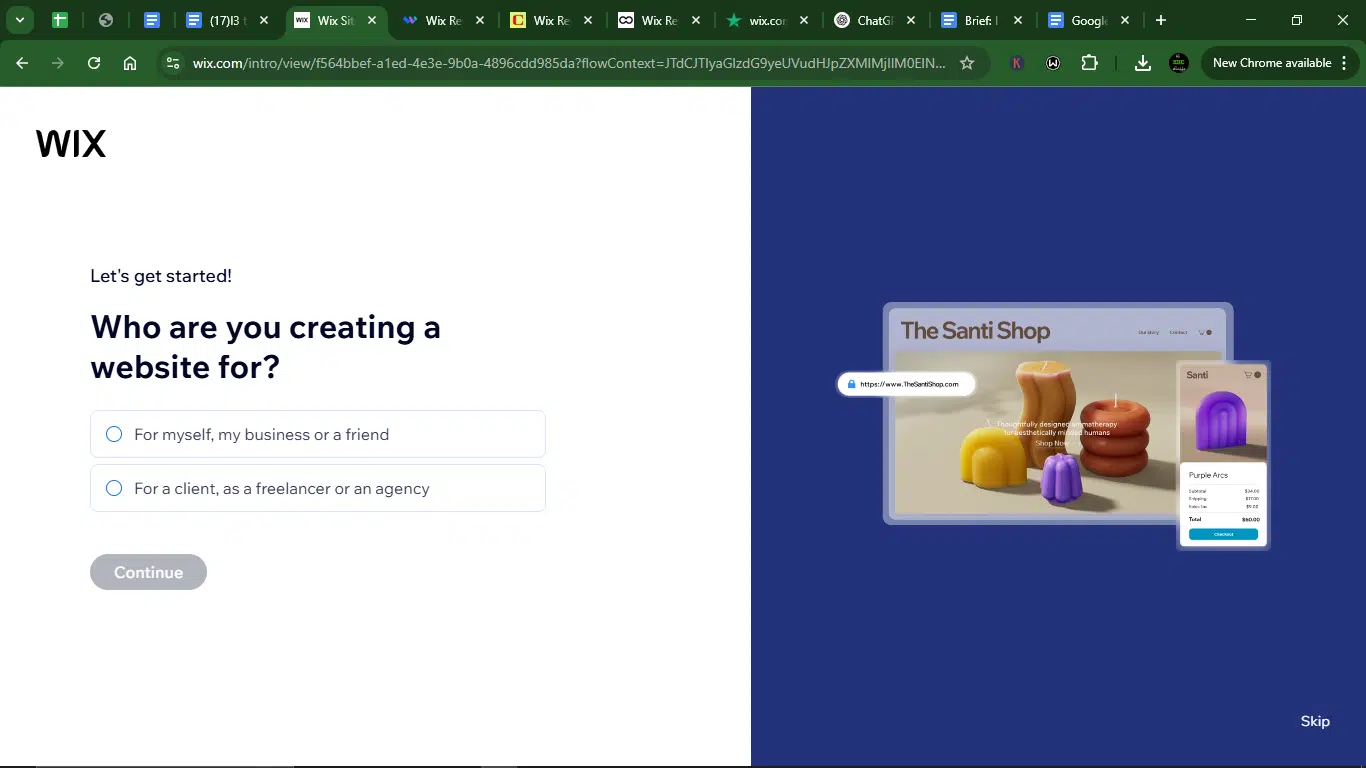
- Choose whether to use Wix ADI or build manually: Next, I had two options: build my website with the help of Wix’s in-built AI chatbot or set up my website manually. From the screenshot below, you’ll see that Wix wants you to try the AI builder. Try it; it helps simplify the onboarding process.

If you say yes to AI, you get this:
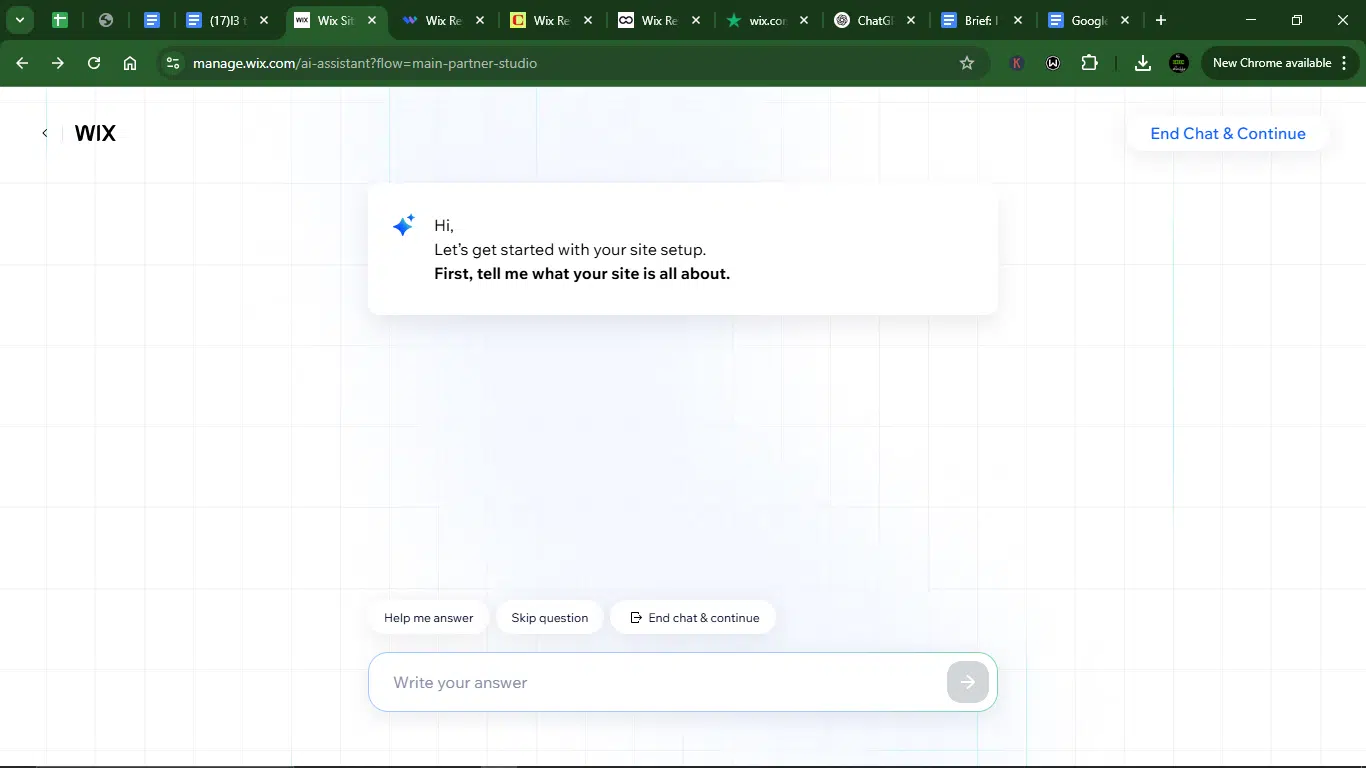
If you opt for without AI, you get this:
- Pick “Portfolio” if you’re a photographer: Before now, you should have already spelled out your goals, site structure, and audience. And since this is a photographer’s website, pick “Portfolio” from the list in the picture above. Afterwards, your dashboard will start loading.
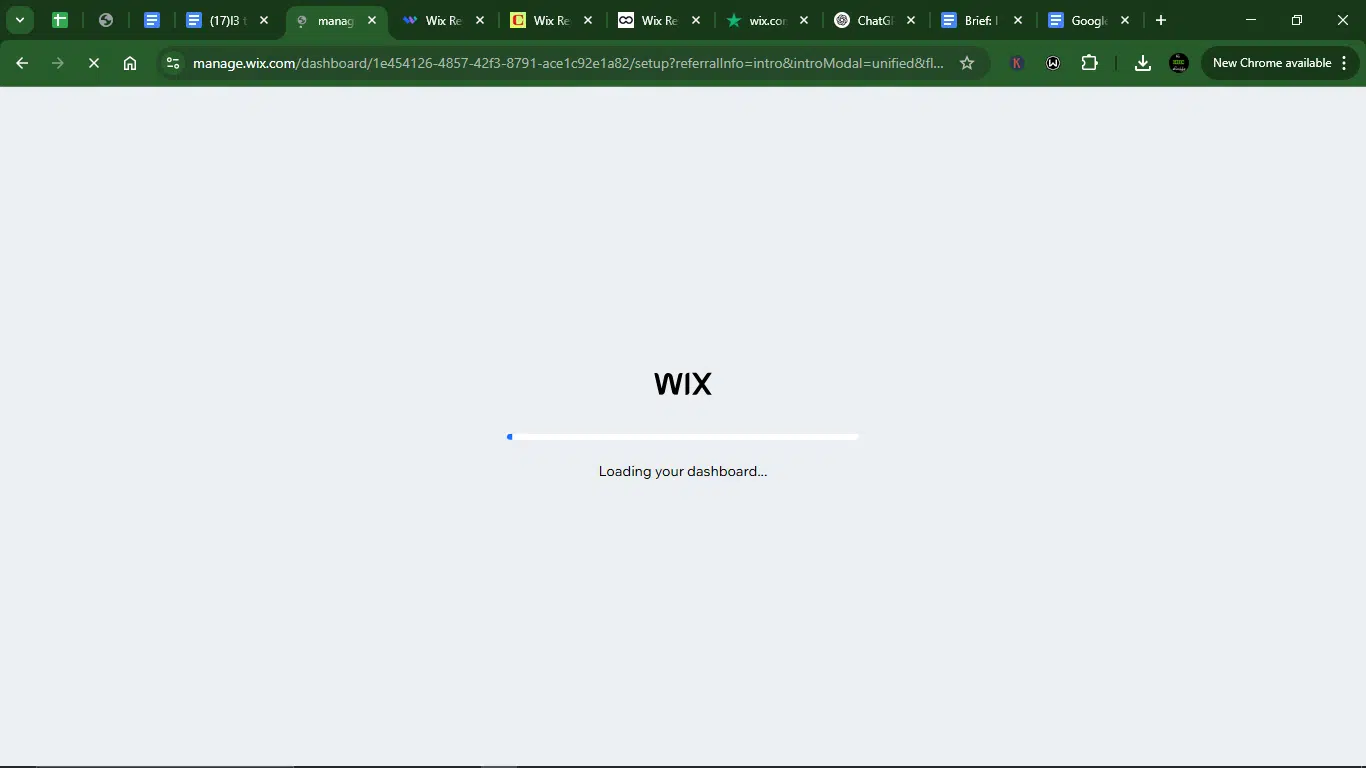
- Name your site: You’ll be asked to enter the name of your website:
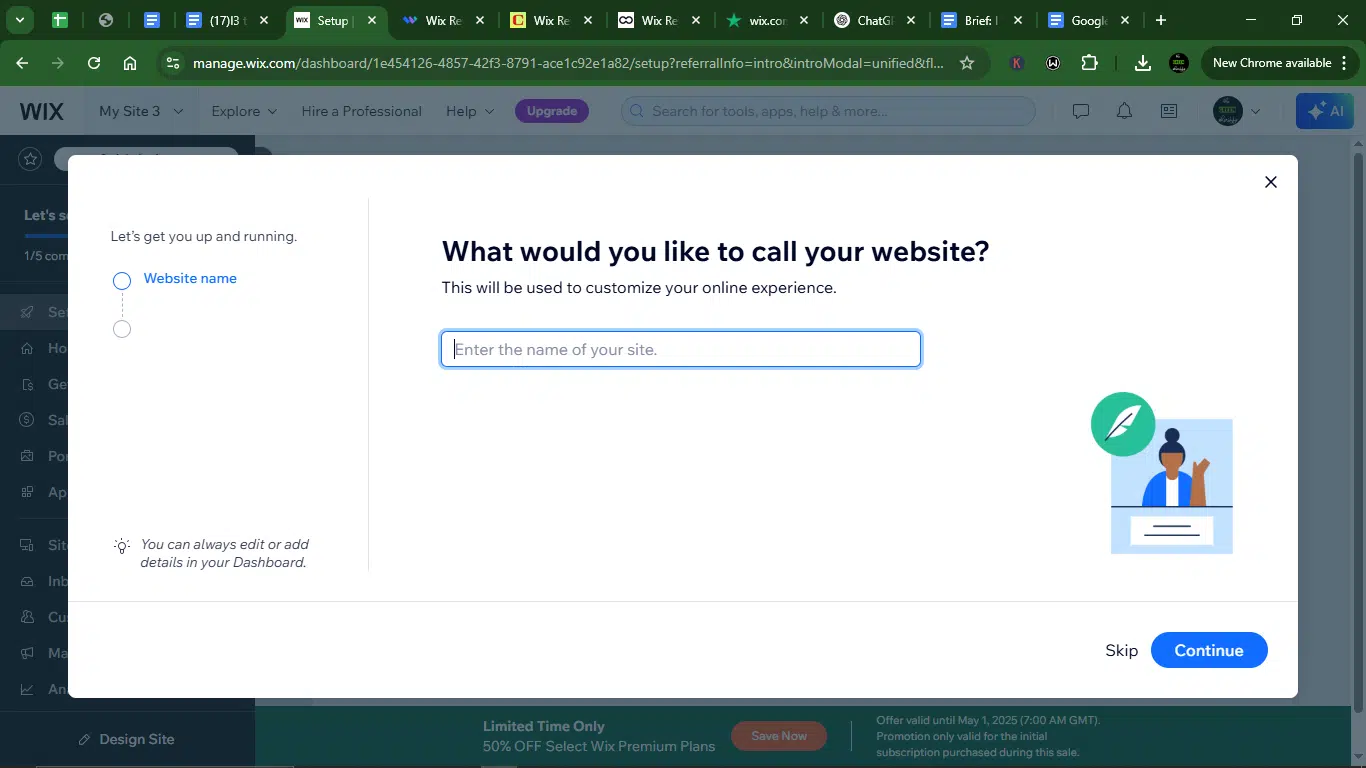
- Add features: Select any app or features (like a blog or online store) you’d like to add.
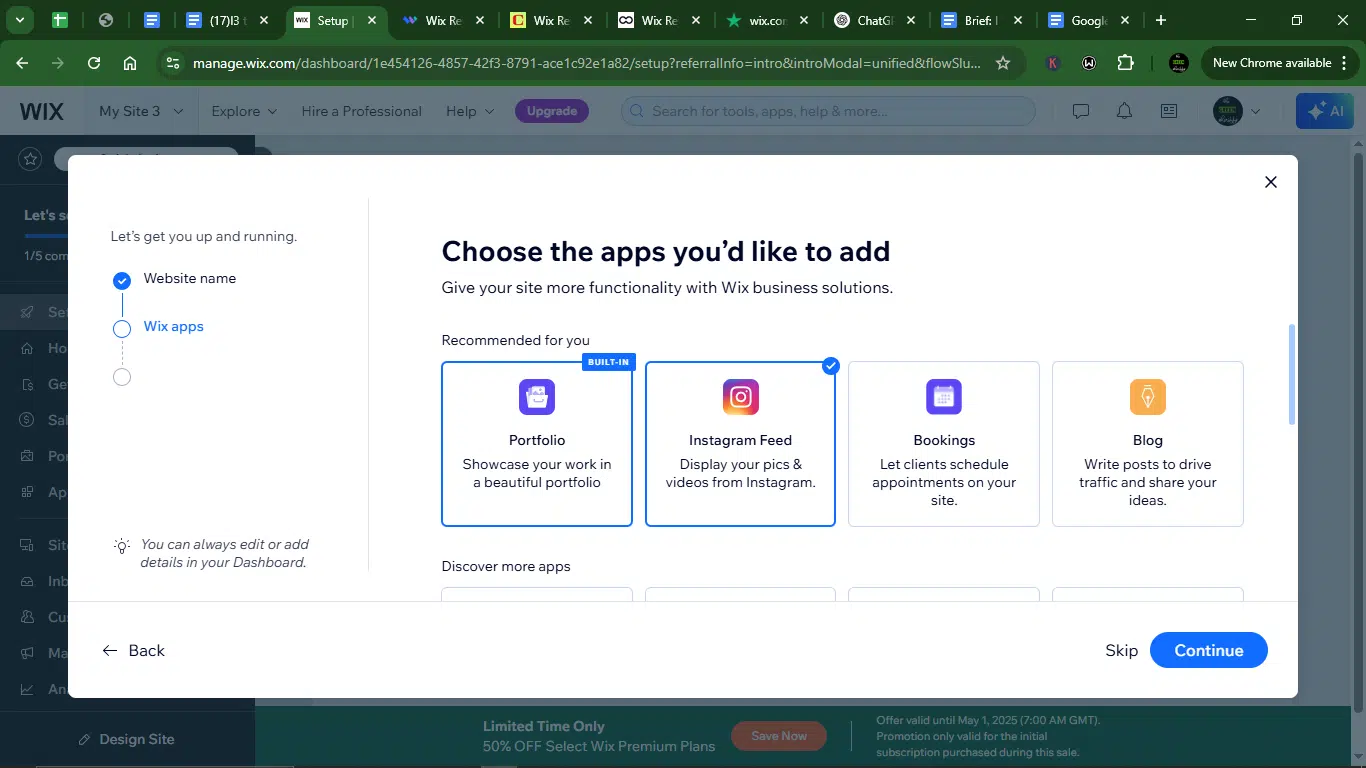
With that, you can go to your dashboard:
- Pick a template: Choose from over 900 free templates or, again, use the AI website builder.
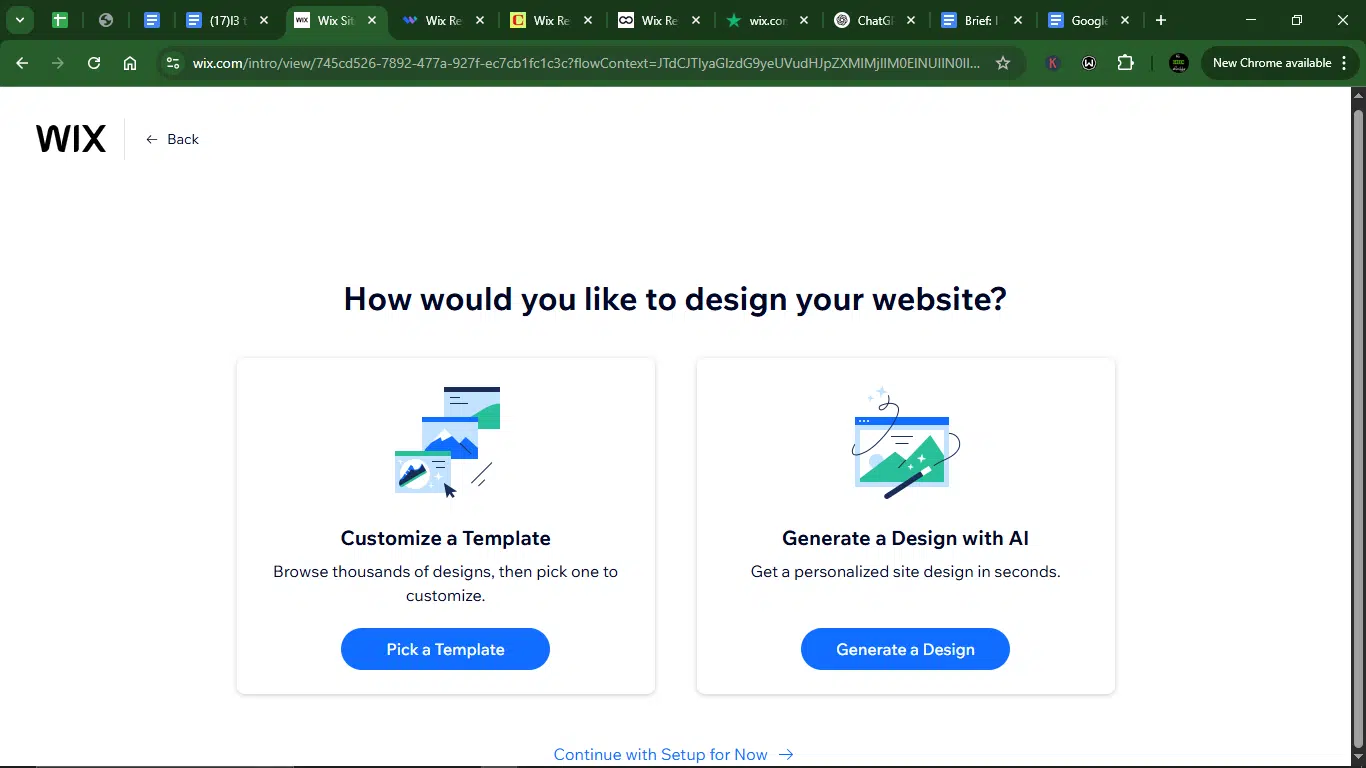
- Customize your dashboard: start building by using the drag and drop editor to tailor your site to fit your brand.
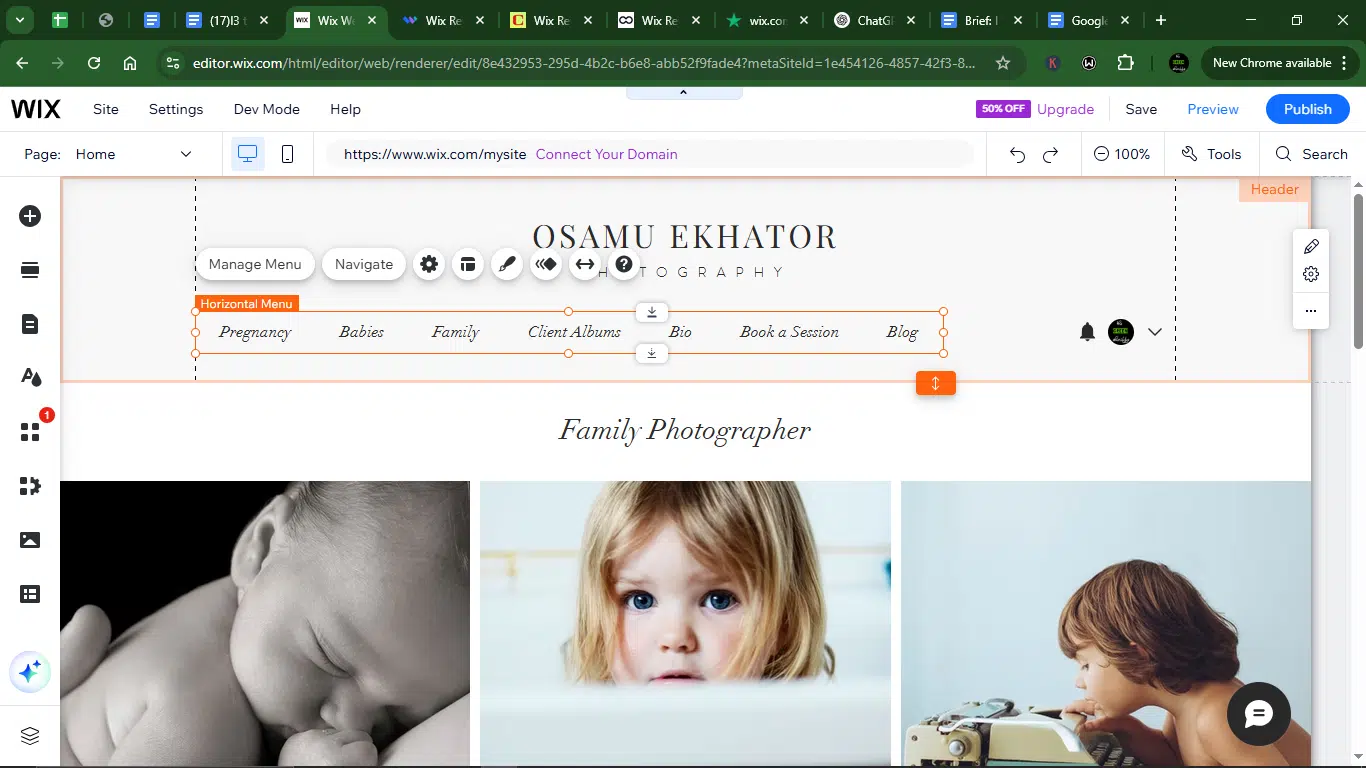
- Use built-in SEO: Optimize for search engines to increase your site’s visibility with a suite of built-in SEO tools.
- Publish your website: Register and connect a custom domain name. When you finish with everything, hit publish and go live.
- Promote the website: Use built-in marketing tools to drive traffic, grow, and expand your reach.
Key features:
- 900+ customizable templates: Professional, clean, and built for every type of photography niche, from weddings to wildlife.
- AI-powered design (Wix ADI): Wix’s AI can build a business-ready site for you in a short time; all you do is answer a few questions.
- Drag-and-drop editor: Move things around exactly how you like them, no coding needed.
- Client proofing galleries: Create private galleries with password protection, a dream way of sharing work with clients.
- Image optimization: Wix automatically ensures fast-loading photos without losing quality.
- Built-in SEO tools: Get found on Google with automated SEO features and personalized suggestions.
- Marketing hub: Email campaigns, social media integrations, and more.
- 24/7 customer support: Help is always just a chat or call away.
- Domain name: Yes, you can get a domain name from Wix!
Pricing:
| Plan | Cost | Description | Best for |
| Light | $17/mo | Free domain for 1 year2 GB storage spaceMulti-cloud hostingLight marketing suit2 site collaborators | Personal websites and professional portfolios |
| Core | $29/mo | Free domain for 1 year50 GB storage spaceMulti-cloud hostingBasic marketing suiteAccept paymentsBasic eCommerce5 site collaborators | Blogs, eCommerce stores, and small photography business websites |
| Business | $36/mo | Free domain for 1 year100 GB storage spaceMulti-cloud hostingStandard marketing suiteAccept paymentsStandard eCommerce10 site collaborators | Medium-sized business websites (looking to scale your business) |
| Business Elite | $159/mo | Free domain for 1 yearUnlimited storage spaceMulti-cloud hostingAdvanced marketing suiteAccept paymentsAdvanced eCommerceAdvanced developer platform100 site collaborators | Large business websites |
Note: Wix offers a 14-day money-back guarantee.
What I liked about Wix:
- Total creative control: You can tweak fonts, layouts, backgrounds, and everything else. It’s like Photoshop for websites.
- Beginner-friendly interface. Even if you’ve never built a website before, Wix makes the process feel doable.
- Photographer-focused features. The client galleries, high-res display options, and artistic templates are tailored to our needs.
- All-in-one dashboard: Manage your site, bookings, emails, and even payments from a single control center.
- Helpful AI assistant: From site design to SEO and content, the AI does a lot of the grunt work.
- Free plan: No pressure to pay right away. Wix lets you test things out free of charge, and you only have to upgrade when you’re ready.
What I Didn’t Like About Wix:
- Template lock-in: Once your site is live, you can’t switch templates, which can be frustrating if you want a total redesign later.
- Overwhelming for first-timers: With so many tools and settings, it can feel like walking into a fully stocked studio with no clue where to start. But the interface makes this more manageable.
- Storage is capped: Unlimited storage only comes with the top-tier plan. Other platforms (like Squarespace) are a bit more generous here.
- Performance dips: I noticed slow loading times during testing, especially when loading image-heavy galleries.
- Pricey upgrades. The free plan is great, but premium plans aren’t the cheapest, especially when you start adding advanced features.
2. Squarespace
Out of all the website builders I tested, Squarespace was the easiest to use, especially if you’re a visual person, which I assume all photographers are. As a photographer, you probably understand the weight of their slogan: “A website makes it real.” For a writer and a creative like me, that hits home.
Squarespace gives you a clean, drag-and-drop editor, and within minutes, you can turn your ideas into a stunning, professional portfolio that works on mobile; no coding needed. Its sleek templates are built to let your work shine, and for photographers, bloggers, and even small business owners, it’s hard to beat the balance of design and simplicity.
Squarespace is for photographers who want a polished online portfolio fast, creatives who appreciate strong visual design, beginners who don’t want to stress about backend tech stuff, service providers offering bookings via Acuity Scheduling, and small online stores selling a few products
That said, Squarespace isn’t for everyone. If you’re running a multilingual site or scaling a large eCommerce operation, Squarespace might feel too limited. In that case, tools like Shopify or WordPress might be better options.
| Developer | Squarespace, Inc. |
| Year launched | 2003 |
| Type of AI tool | Website Builder with some AI integration for design assistance |
| Top 3 use cases | Portfolio creation, blogging, and online stores |
| Who can use it? | Photographers, bloggers, and small business owners |
| AI capabilities | Template customization through AI-based design suggestions |
| Starting price | $16/month (Personal Plan) |
| Free plan or trial? | 14-day trial |
| Truspilot review | 1.4/5 |
How Squarespace works:
Here’s how to create a website using Squarespace:
- Decide what your site is for: Portfolio? Blog? Online store?

Next, clarify exactly what you want to do with it.
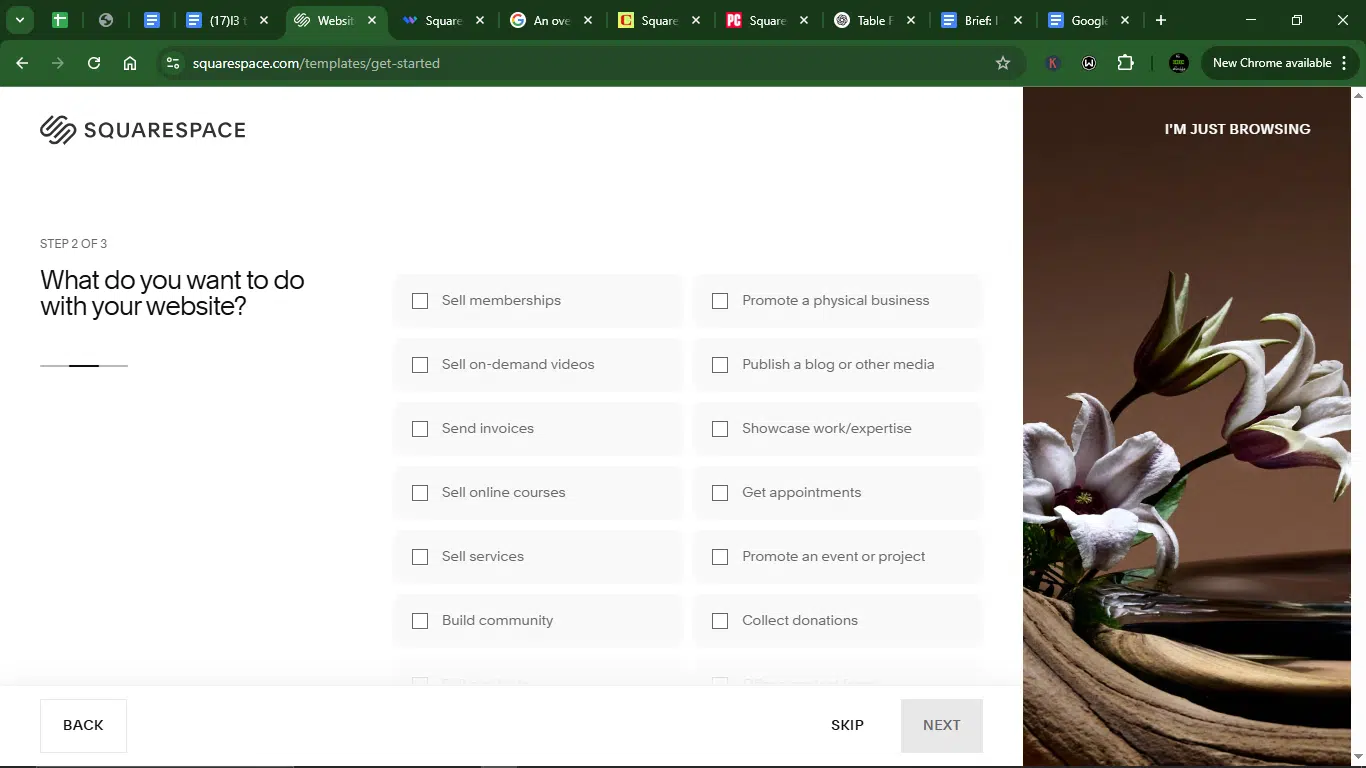
- Pick a template: Or use their AI to help you build from scratch. You can kick things off with their 14-day trial. That said, a free custom domain name comes with the first year of an annual website plan.
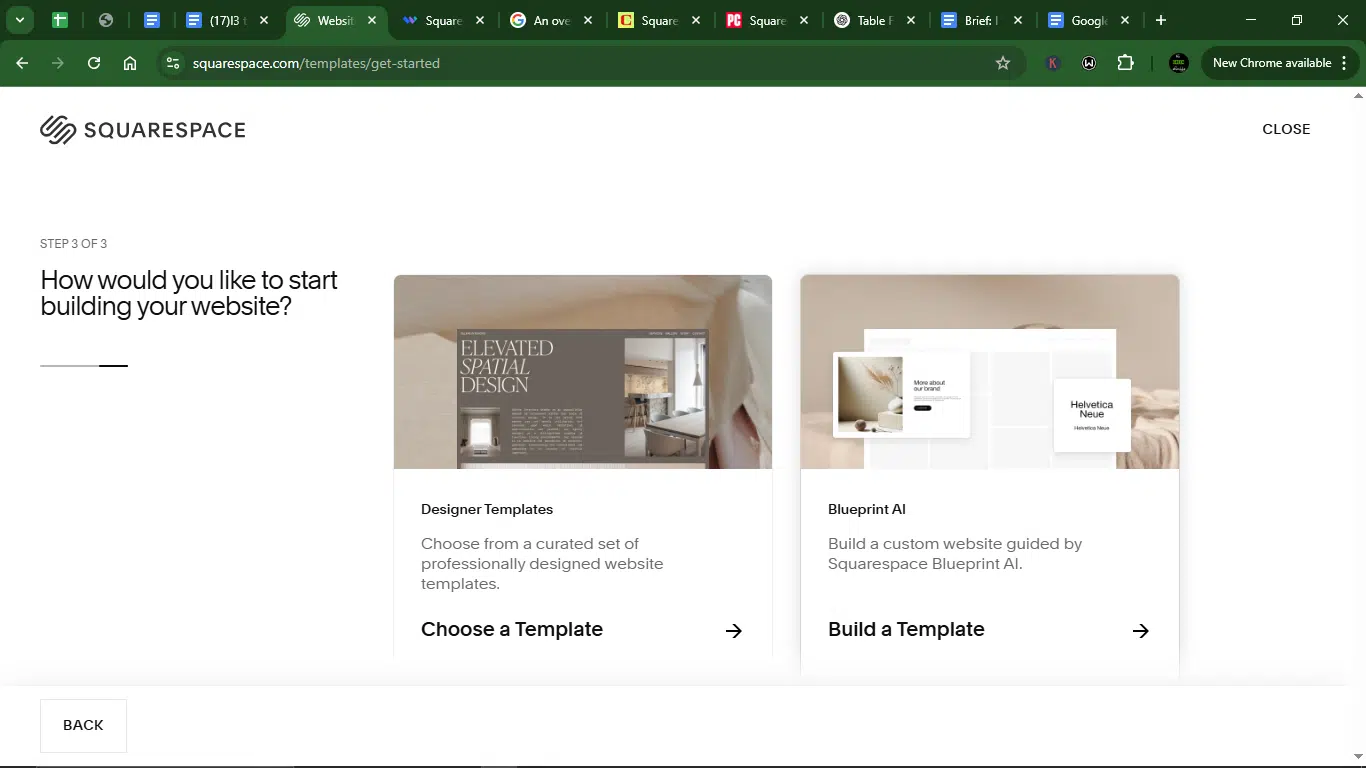
- Customize your website: Use the website builder to add your text, photos, branding, colors, and fonts. If you don’t have a logo, you can make one for free with their online tool, or check out my previous article for options.

- Hit publish: Publish your site and promote using their built-in email and social tools.
Key features:
- 180+ Templates: Clean, modern designs that make your photos pop.
- Drag-and-drop builder: Seriously intuitive. It feels like designing a magazine spread.
- Integrated eCommerce: Squarespace lets you sell prints, downloads, and other products easily.
- Mobile optimization: All templates work beautifully on mobile phones and desktops.
- Domain name availability: Get a free custom domain with annual plans.
- Blueprint AI: An AI assistant that builds your first layout in minutes.
- Built-in marketing tools: Email campaigns, social sharing, and SEO features are designed right in.
- Unlimited storage: Every plan comes with unlimited storage.
- Acuity scheduling integration: Great if you’re offering sessions or bookable services.
Pricing:
| Plan | Monthly cost | Best for | Description |
| Personal | $16 billed yearly, $20 billed monthly | Individuals building a personal brand or portfolio | Fully customizable, best-in-class templatesMobile-optimized websitesTemplates to fit every needFree custom domain*Send invoices for freeAccept payments0% transaction fee on invoices |
| Business | $23 billed yearly, $36 billed monthly | Entrepreneurs growing their audience and starting to monetize | All features in PersonalAdvanced website analyticsCheckout on your domainAdvanced shipping options3% transaction fee on online store transactions0% transaction fee on invoices |
| Commerce Basic | $28 billed yearly, $40 billed monthly | Small businesses selling online with no transaction fees | All features in BusinessPowerful merchandising tools0% transaction fees across invoices and storeA checkout option with your domainAdvanced shipping |
| Commerce Advanced | $52 billed yearly, $72 billed monthly | Growing eCommerce brands in need of full flexibility | All features in Commerce BasicAdvanced discountingSell subscriptionsSell products & services0% transaction fees |
| Enterprise | Custom | For larger teams | Custom |
Note: 14-day free trial available. No free plan.
What I liked about Squarespace:
- Design-forward: Perfect if you want a high-end aesthetic without hiring a designer.
- Beginner-friendly: I didn’t need to Google anything to get started, and that’s rare.
- Solid eCommerce: Selling digital downloads and services is super easy.
- Reliable mobile optimization: Every site looks great on phones and tablets.
- Acuity integration: Bookings are seamless if you’re offering sessions.
- SEO-friendly: Built-in tools to help your site get noticed.
- Unlimited storage: No need to worry about running out of space.
What I didn’t like about Squarespace:
- Limited customization: The templates are beautiful, but rigid. WordPress and Wix offer more freedom if you’re picky.
- Pricing climbs fast: Advanced features cost quite a bit more, especially if you pay monthly instead of yearly.
- No autosave: In 2025, this seems like a big miss.
- No free plan: Unlike Wix, you can’t use Squarespace for free beyond the 14-day trial.
- Template lock-in: Once you choose a template, you can’t switch to a different one without rebuilding the site.
3. WordPress + Elementor
If you’re the type of photographer who likes full control, the kind who’d rather build your studio from scratch than rent one, then WordPress with Elementor is your best bet. It’s not the easiest combo to start with, but once you get the hang of it, you don’t want to stop. Total creative freedom.
Elementor is a drag-and-drop builder that plugs into WordPress and turns it into your personal playground. No code needed. Just blocks and beautiful layouts.
Used by millions of WordPress websites, Elementor enables you to:
- Build a complete website without touching a line of code.
- Drag and drop content and feature blocks to create the perfect design.
- Preview a page to see what it will look like as you’re building it.
| Developer | WordPress.org + Elementor |
| Year launched | 2003 (WordPress) + 2016 (Elementor) |
| Type of AI tool | Website Builder (with advanced AI tools through plugins) |
| Top 3 use cases | Portfolio creation, blogging, and business websites |
| Who can use it? | Photographers, bloggers, developers, and DIYers |
| Starting price | $4.99/month for Elementor, $4/month for WordPress hosting |
| Free plan or trial? | Yes (for basic use, self-hosted WordPress) |
| Truspilot review | 1.5/5 |
How WordPress + Elementor works:
WordPress is a self-hosted full content management system (CMS) where you manage pages, blog posts, plugins, and users. Think of it as your digital office.
Elementor, on the other hand, is like your interior designer. It’s a page builder plugin for WordPress that lets you craft beautiful page layouts by dragging and dropping blocks, all without touching code.
How they work together:
- You install WordPress on a hosting server.
- Inside WordPress, you install Elementor (free or Pro version).
- Launch Elementor and start customizing every inch of your site, from your homepage.
Elementor kicks things off by asking who you’re building the site for and what type of website it is.
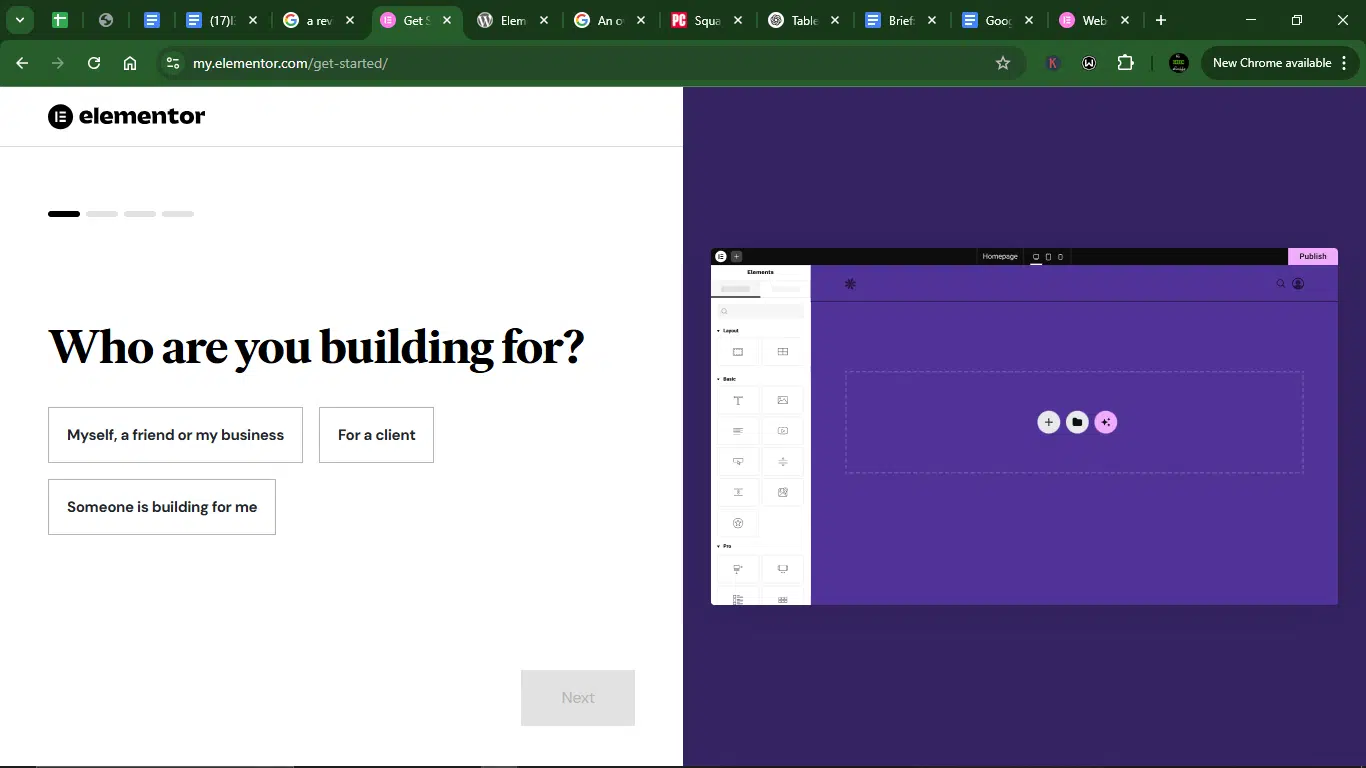
Next, you’ll be asked if this is your first Elementor website:
From there, you’ll need to state what type of website you’re building. As a photographer, go for the “Business/Portfolio” option. From there, you’re in full control.
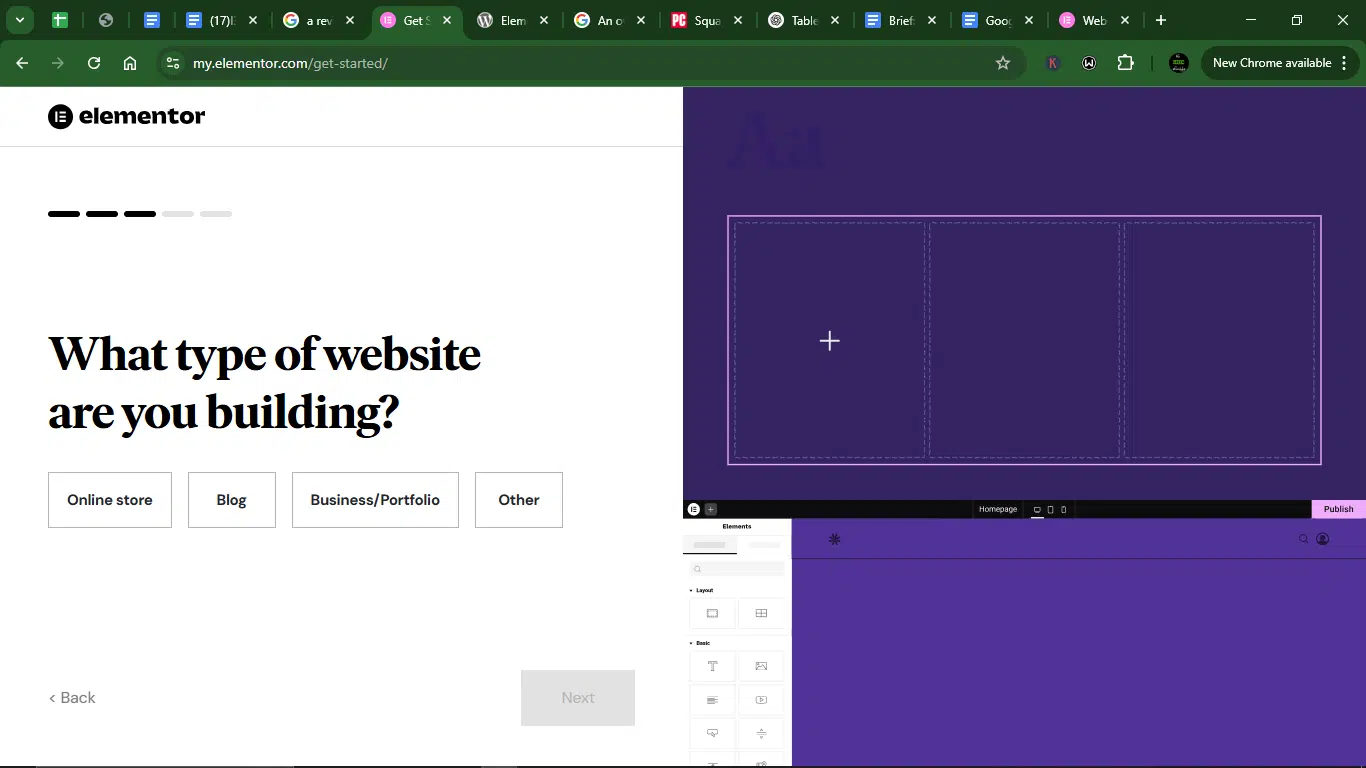
Key Features:
- Endless customization: Thousands of plugins, themes, and widgets to match your exact vision.
- SEO plugins: Tools like Yoast SEO give your site an edge in Google rankings.
- Galleries: Use plugins like Envira Gallery to set up private client galleries.
- Content elements: Drag and drop blocks for text, images, forms, and more.
- Elementor AI: Helps you generate content, images, and code with AI.
- Theme builder: Design your site’s theme entirely within Elementor Pro.
- Templates: Hundreds of pre-built templates (especially from Astra) to jumpstart your design.
- Style options: Tweak colors, fonts, spacing, and everything, without touching CSS.
- WooCommerce builder: Design your online store with drag-and-drop ease.
Pricing:
Elementor
| Plan | Cost | Best for | Key features |
| Essential | $4.99/mo($60 billed annually) | Basic single-site users needing core design tools | 1 site, 24/7 support, 57 Pro widgets, theme builder, dynamic content, and form builder |
| Advanced Solo | $6.99/mo($84 billed annually) | Individual professionals or eCom startups | 1 site, 24/7 Support, 86 Pro widgets, theme builder, dynamic content, form builder, popup builder, custom code & CSS, eCommerce features, and collaborative notes |
| Advanced | $8.25/mo($99 billed annually) | Professionals managing a few websites | Up to 3 sites and all features in Advanced Solo |
| Expert | $16.99/mo($204 billed annually) | Freelancers or agencies managing multiple sites | Up to 25 sites, 24/7 premium support, all features in Advanced Scalable for larger client needs |
WordPress hosting:
| Plan | Cost | Best for | Description |
| Personal | $4/mo($48 billed annually) | Beginners creating a personal blog or a simple website | 6 GB storage, free domain, ad-free, expert support, unlimited pages, posts, users, and visitors, dozens of premium themes, and traffic stats access |
| Premium | $8/mo($96 billed annually) | Users wanting more customization and video features | 13 GB storage, Google Analytics, all premium themes, fast expert support, premium stats with UTM & device insights, customize fonts & colors sitewide, upload 4K videos (ad-free, with subtitles), and – everything in Personal |
| Business | $25/monthly($300 billed annually,) | Developers and content creators in need of plugins & power tools | 50 GB storage, priority 24/7 support, install plugins, SFTP/SSH, WP-CLI, Git & GitHub Deployments, WooCommerce-ready for online store setup, and everything in Premium |
| Commerce | $45/mo($540 billed annually, excl. taxes) | Businesses running full-scale online stores | 50 GB storage, all premium + store themes, full suite of eCommerce tools, optimized WooCommerce experience, and everything in Business |
What I liked about WordPress + Elementor:
- Full control: Every design choice is yours. If you can dream it, you can build it.
- Scalability: Start simple and scale up as your photography business grows.
- SEO capabilities: WordPress is still king when it comes to SEO.
- Responsive design: Every layout adapts to mobile, tablet, or desktop.
- Convenience: Handy tools like right-click, quick finder, and global settings.
- Free version: The free Elementor and WordPress combo already gives you a lot.
- No code required: Truly beginner-friendly, even if the dashboard looks intimidating at first.
- Constant updates: Elementor is always improving with new features and UI tweaks.
- Solid AI tools: Elementor AI holds its own in content and code generation.
What I didn’t like about WordPress + Elementor:
- Learning curve: Compared to Wix or Squarespace, this setup takes more time to learn.
- Maintenance required: You’re responsible for plugin updates, backups, and security.
- Premium lock-ins: Many powerful features are locked behind Elementor Pro or paid plugins.
4. Pixpa
Pixpa claims it’s been “the go-to website builder for top creatives” for over a decade. As someone who’s tested more website builders than I care to admit, I was curious to see if Pixpa could live up to the hype or if it’s just another platform throwing around buzzwords to woo photographers.
After giving it a proper spin, here’s what I found.
Pixpa is a website builder designed with photographers and creatives in mind. It rolls your portfolio, online store, blog, and client galleries into one affordable, user-friendly platform. Think of it as a one-stop shop for showcasing and selling your work, without touching a single line of code.
From the jump, Pixpa makes setup easy. Once you sign in, you’re walked through picking a template, color palette, and font combo, like building a visual brand starter kit. From there, you’re free to drag and drop your way to a sleek portfolio or online store.
| Developer | Pixpa Inc. |
| Year launched | 2012 |
| Type of AI tool | AI-enhanced design assistance |
| Top 3 use cases | Photography portfolios, client proofing, and online stores |
| Who can use it? | Photographers, small businesses, and eCommerce sellers |
| Starting price | $7/month (Personal Plan) |
| Free plan or trial? | 14-day trial |
| Truspilot review | 4.0/5 |
How Pixpa works:
Once you sign in, you’ll be asked to pick a template:
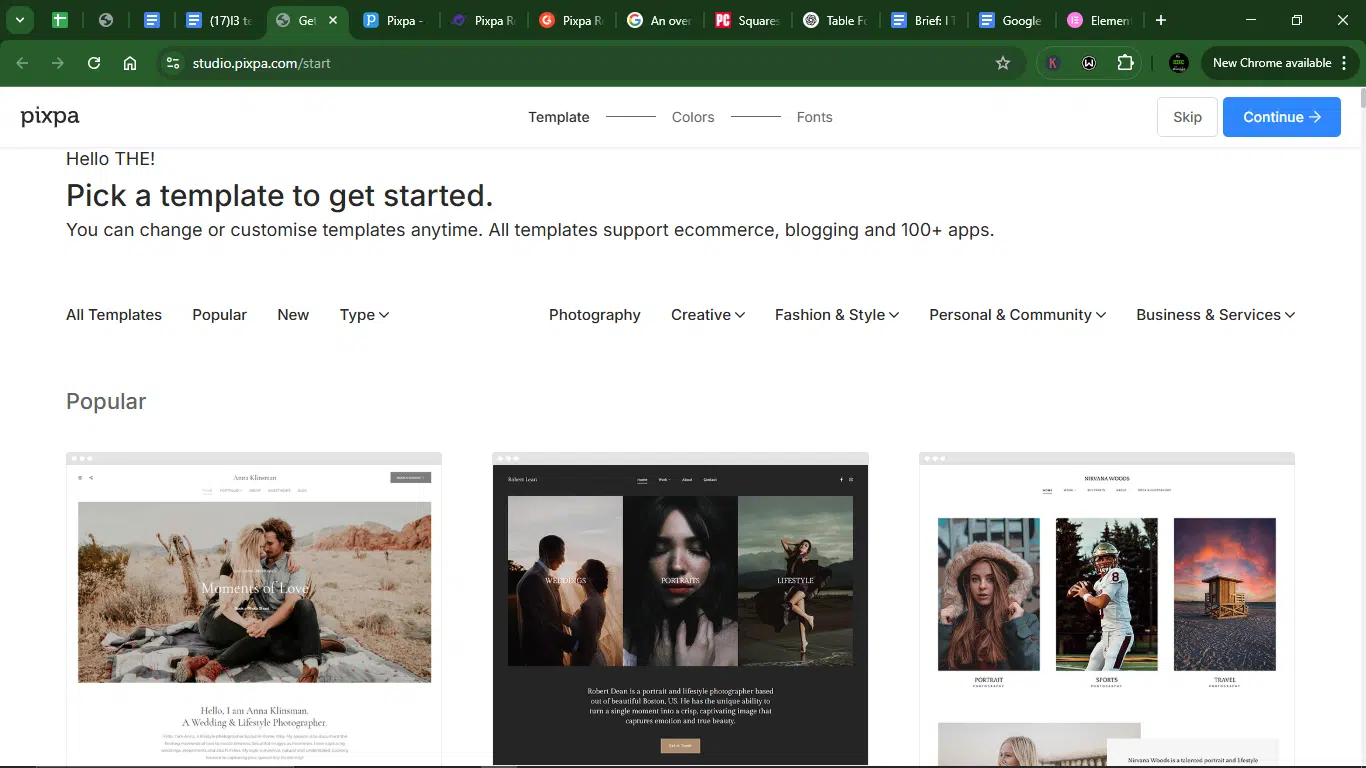
Next, you’ll be asked to choose a colour palette:
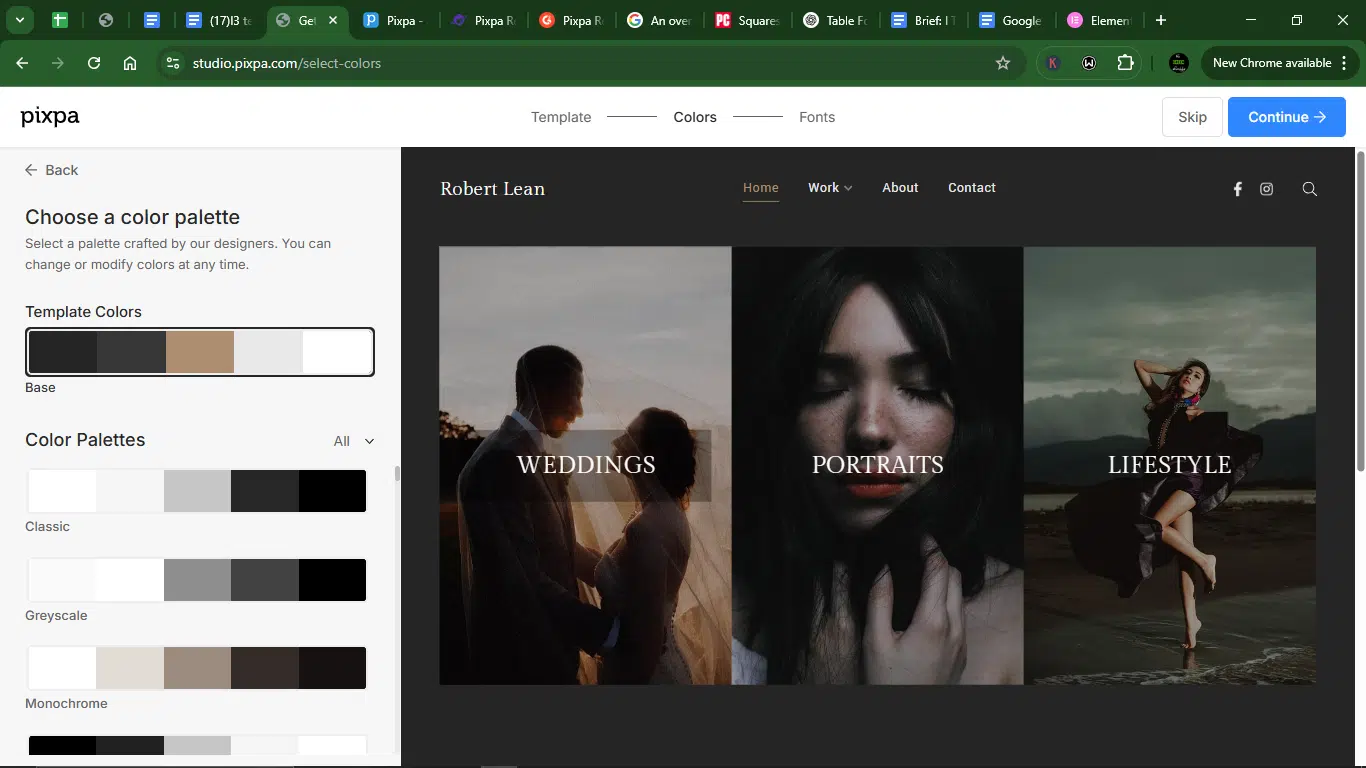
Then, it’s time to choose a font set:
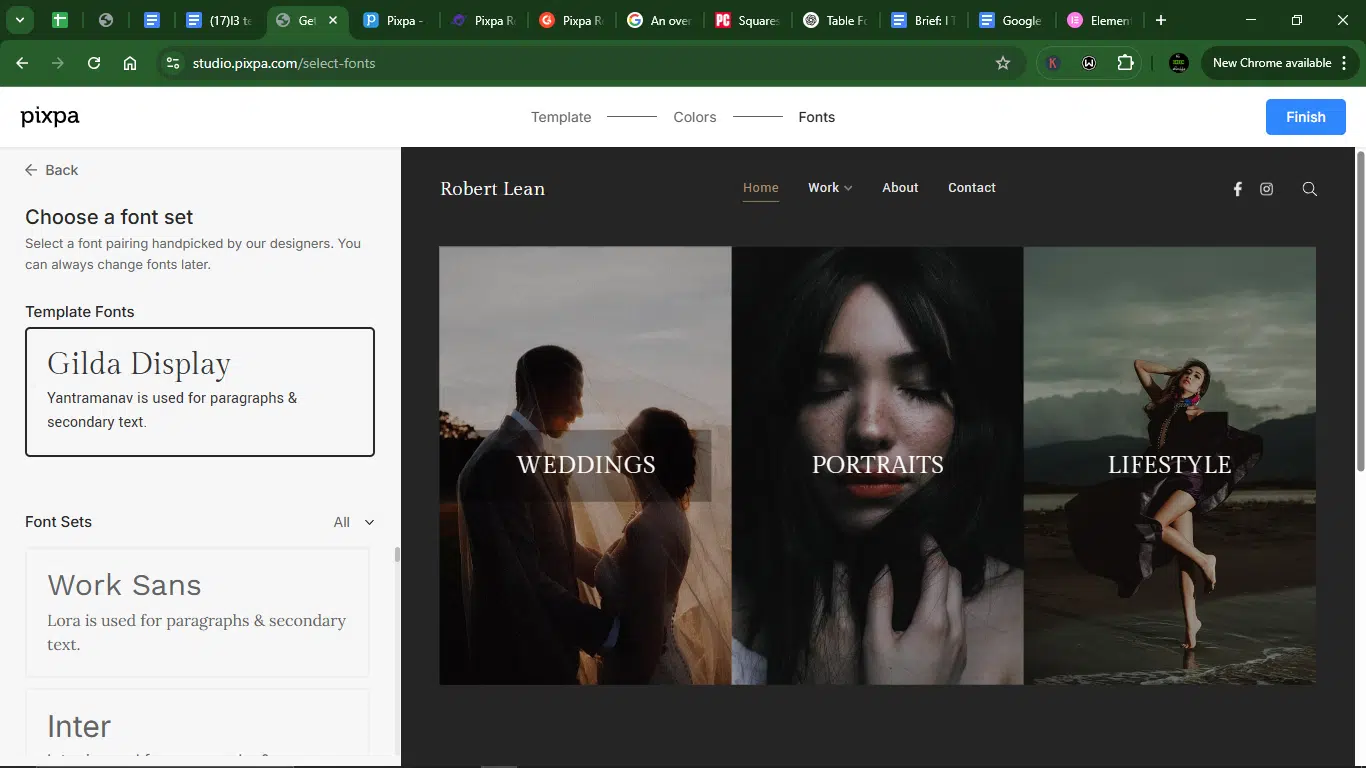
Finally, you can go ahead and build your website:
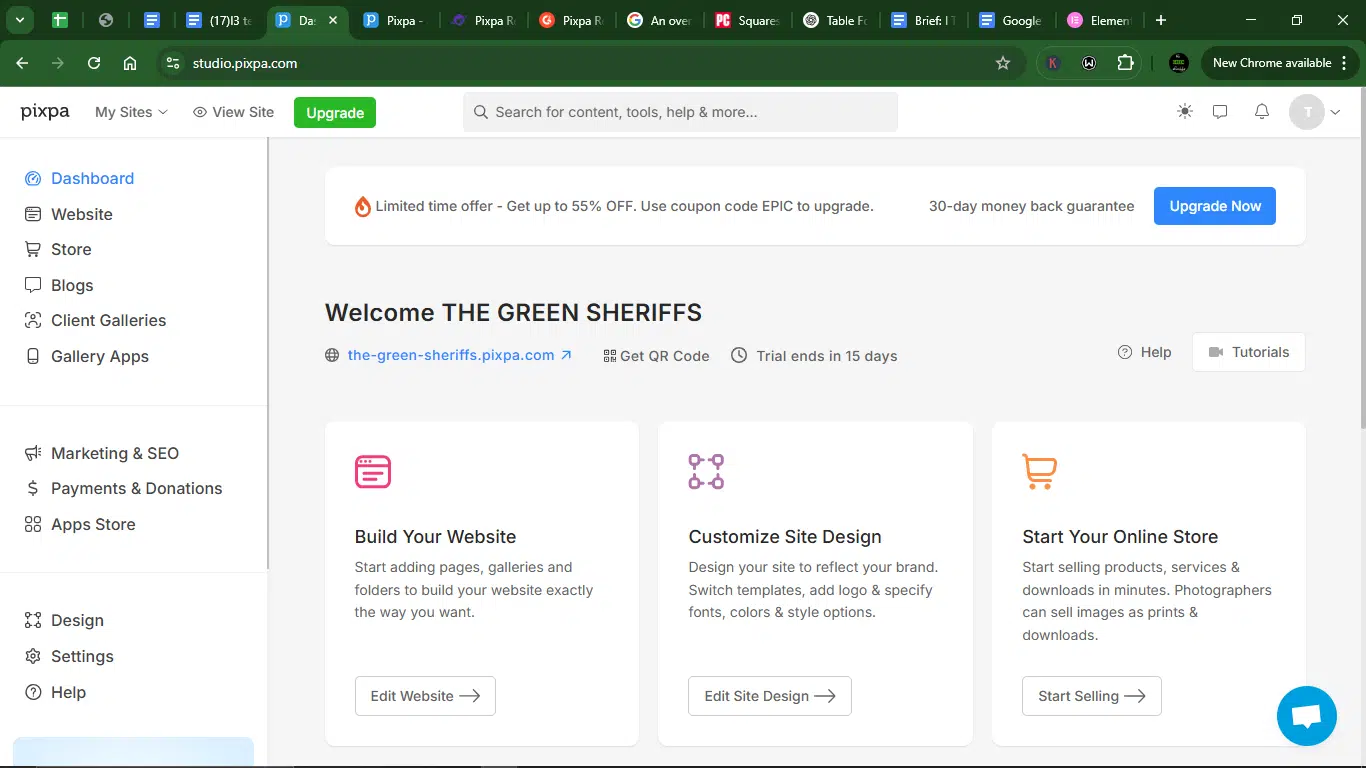
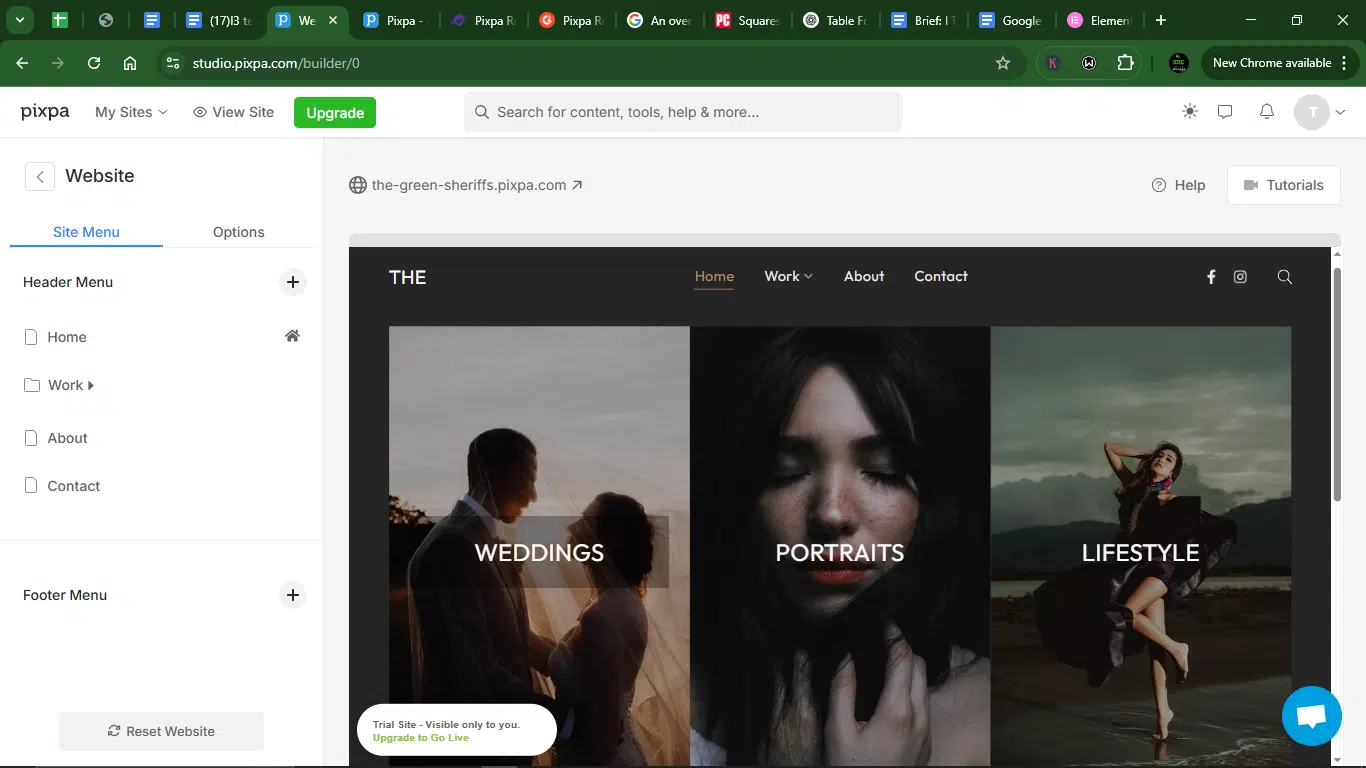
Key features:
- 200+ mobile-ready templates: A strong mix of clean, visually impactful designs.
- Client galleries: Password-protected client proofing galleries for sharing images securely.
- eCommerce integration: Sell prints, digital downloads, and services directly—no third-party plugin needed.
- Built-in blog: Add blog posts to attract traffic and improve SEO.
- Drag-and-drop builder: No coding needed; just pick a block and place it.
- 50+ third-party integrations: Including PayPal, Stripe, Google Analytics, Vimeo, YouTube, and live chat tools like Tawk.to.
- SEO tools: Custom metadata, search-friendly URLs, and auto-generated sitemaps.
- Marketing features: Pop-ups, mailing lists, announcement bars, and email tools are baked in.
Pricing:
| Plan | Description | Monthly cost |
| Basic | Build your personal website effortlessly. | $8 |
| Creator | Stunning portfolio and store in one. | $15 |
| Professional | Showcase, sell, and share like a pro | $20 |
| Advanced | Advanced tools to scale your business. | $25 |
What I liked about Pixpa:
- Affordable: Offers great value, especially for photographers starting.
- All-in-one solution: From portfolios to proofing to online sales, everything lives under one roof.
- Built for creatives: Unlike general website builders, Pixpa understands the visual needs of photographers and artists.
- Client proofing: Sharing and getting feedback from clients is seamless.
What I Didn’t Like About Pixpa:
- Limited customization: It’s easy to use, but not the most flexible in terms of design tweaks.
- Fewer templates: Compared to Squarespace or Wix, the template library is smaller.
- No real drag-and-drop freedom: It’s more like modular editing than freeform drag-and-drop.
- Trial limitations: You can’t publish your site during the free trial.
- Media management: You can’t reuse the same photo in multiple galleries without re-uploading it.
5. Format
When I first landed on Format’s homepage and saw the tagline, “Portfolios for creatives with vision,” I knew exactly who it was for. Photographers. Like, screaming-for-photographers levels of clarity. And true to that, Format isn’t trying to be everything for everyone. It’s for creatives who want to showcase their work without fiddling with code or losing hours customizing pixel-perfect layouts.
I gave it a spin and found out some things.
| Developer | Format, Inc. |
| Year launched | 2011 |
| Type of AI tool | Portfolio management with AI-driven layout suggestions |
| Top 3 use cases | Portfolios, client galleries, and selling prints |
| Who can use it? | Photographers, creative professionals |
| Starting price | $6/month (Personal Plan) |
| Free plan or trial? | 14-day trial |
| Truspilot review | 2.2/5 |
How Format works:
On Format, signing up gets you a 14-day free trial (no credit card drama), after which you can pick from one of their paid plans.
From there, it’s all about ease: drag-and-drop editing, modern templates (80+ of them), and the ability to launch a beautiful portfolio site in less than a day.
You pick from 80+ clean templates, upload your work, and Format handles the rest. It also comes with tools for client proofing, scheduling, and invoicing, all essentials for photographers managing their own gigs. And if you’re not in the mood to do any of that, you can just hire a Format expert to build the site for you via their Website Building Service.
The interface is clean but not exactly intuitive out of the gate. I had to poke around a bit before things started to feel natural. That said, once I got the hang of it, Format did what it promised: helped me create a stunning portfolio site with minimal stress.
Key features:
- Portfolio management: Upload photos and videos, organize them, and showcase them beautifully online.
- Client proofing: Share albums with clients and let them give feedback or select images directly.
- Scheduling and invoicing: Handle bookings and payments from the same platform.
- Templates designed for creatives: Built by award-winning designers, tailored to artists and photographers.
- Mobile optimization: All templates are fully responsive across devices.
- Website building service: Pay extra and let Format’s pros build your site for you. It’s great for beginners or time-strapped pros.
- Image copyright protection: Stop random people from screenshotting or stealing your work.
- SEO tools: Built-in tools to help your portfolio get discovered on Google.
Pricing:
| Plan | Basic | Pro | Pro Plus |
| Best For | Start your creative career | Build your business | Grow your business |
| Price (billed annually) | $8/month | $11/month | $13/month |
| Price (billed monthly) | $12/month | $24/month | $36/month |
| Description | 10 web pages, 70 high-resolution (HD) images | Unlimited web pages, 1500 HD images, 100 GB image storage, 15 minutes of hosted video | Unlimited web pages, unlimited HD images, 1 TB image storage, 120 minutes hosted video |
What I liked about Format:
- Simplicity: Format is super beginner-friendly. You won’t need a single line of code.
- Photographer-first tools: The client proofing and scheduling tools are a huge plus if you’re managing shoots.
- Clean, professional templates: Honestly, some of the best-looking portfolio templates I’ve seen.
- Mobile-Ready: No stress about how your site looks on mobile. Format handles that for you.
- Great Support: The 24/7 customer care team is responsive and helpful. You’re not left hanging if you need help.
What I didn’t like about Format:
- Weak eCommerce tools: You can sell prints, but if you’re serious about online sales, this isn’t the platform for you.
- No permanent free plan: There’s only a 14-day trial. After that, it’s pay or leave.
- Basic blogging features: Don’t expect a full-fledged blog. Format’s blogging tools are very limited.
- Limited customization: If you want deep custom tweaks or complex site features, you’ll hit a wall.
- Clunky UI: While it’s not terrible, the user interface isn’t as smooth or modern as I’d like. There’s a bit of a learning curve.
6. SmugMug
The moment you land on the homepage of SmugMug, you know exactly who it’s built for: photographers who mean business. Whether you’re looking to showcase your portfolio or turn your photography into a source of income, SmugMug is more than just a website builder; it’s your photo lab, sales assistant, and storage vault.
You start by signing up for a 14-day free trial (no credit card required). Once you’re in, you choose a clean, photo-centric template and create your first gallery. Upload your images, tweak privacy settings (yes, including password protection), and SmugMug spins up your portfolio site almost instantly.
There’s a focus on security, organization, and eCommerce right out of the box. You can upload full folders, batch edit galleries, and even integrate with Adobe Lightroom to streamline your workflow. Plus, with built-in print fulfillment and client delivery tools, SmugMug is one of the few platforms that lets photographers truly monetize their work.
| Developer | SmugMug, Inc. |
| Year launched | 2002 |
| Top 3 use cases | Print fulfillment, photo storage, private galleries |
| Who can use it? | Photographers selling prints and managing client galleries |
| Starting price | $25/month |
| Free plan or trial? | 14-day trial |
| Truspilot review | 4.4/5 |
How SmugMug works:
- Create an Account: Visit SmugMug’s website and click the green “Start my Free Trial” button, and sign up for the free trial account.
- Customize your account design: Pick your default design template (you can change this later) for your photo gallery.
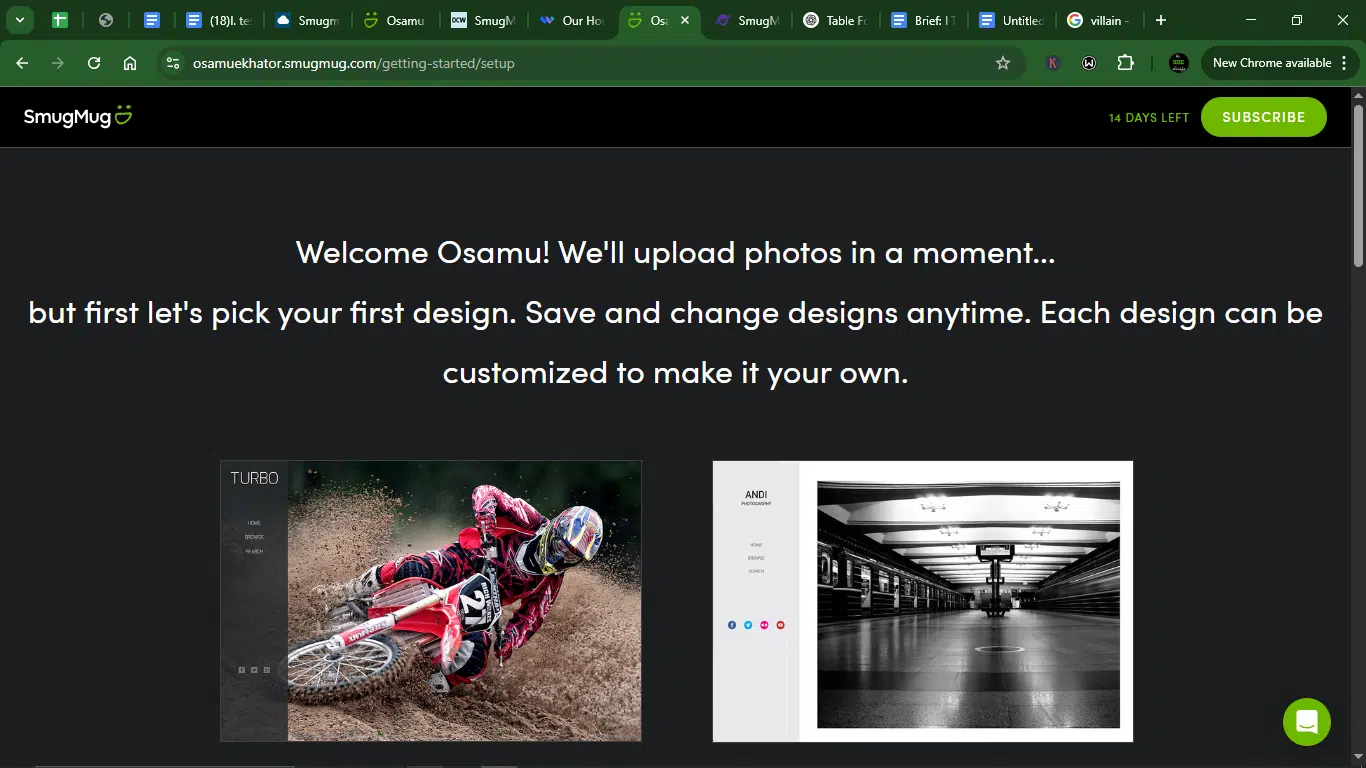
- Create a gallery: Next, create your first gallery and upload a batch of photos to fill it. Then click “show me my site” to continue. SmugMug will start creating your portfolio in a few seconds.
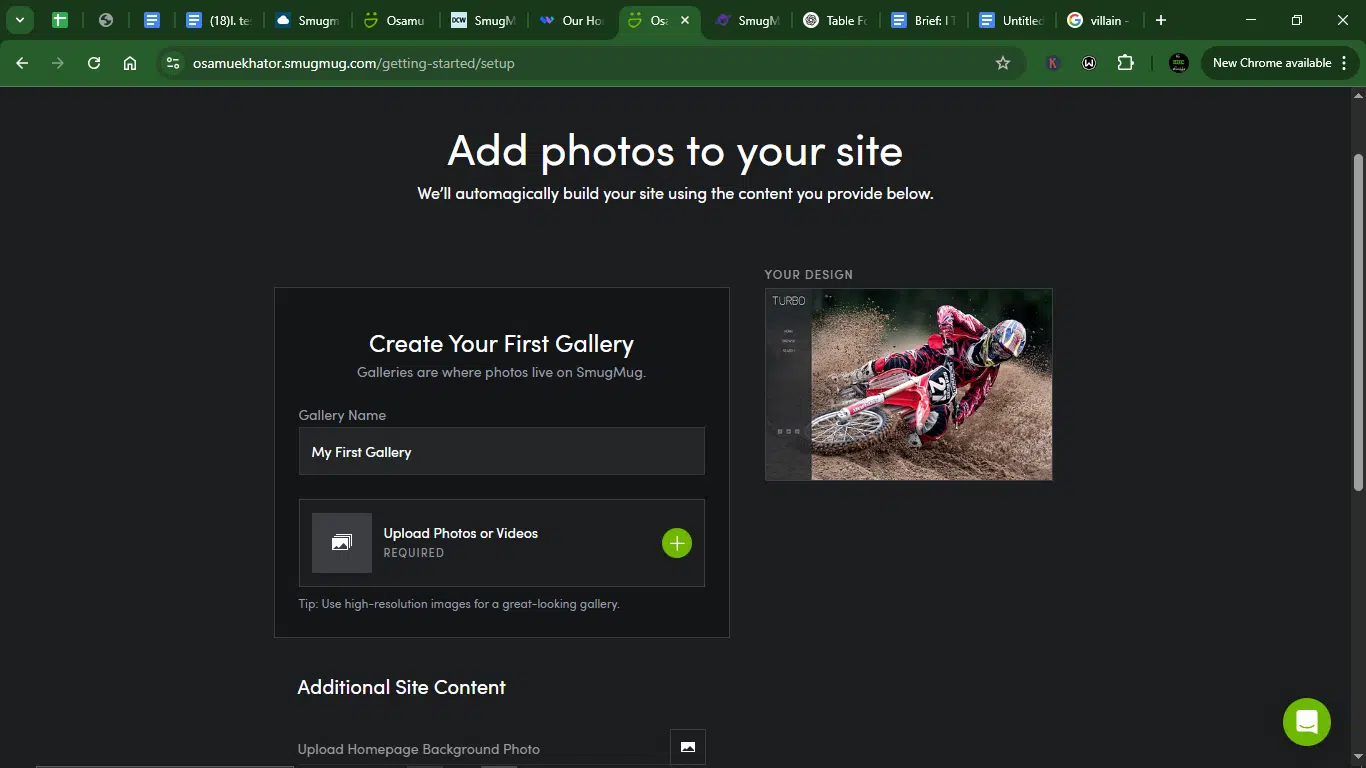
Now that you’ve set up your first gallery, let me quickly walk you through how to continue using SmugMug after the initial setup.
- Upload an Image: On the main screen, click the green “upload” button at the top-left corner.
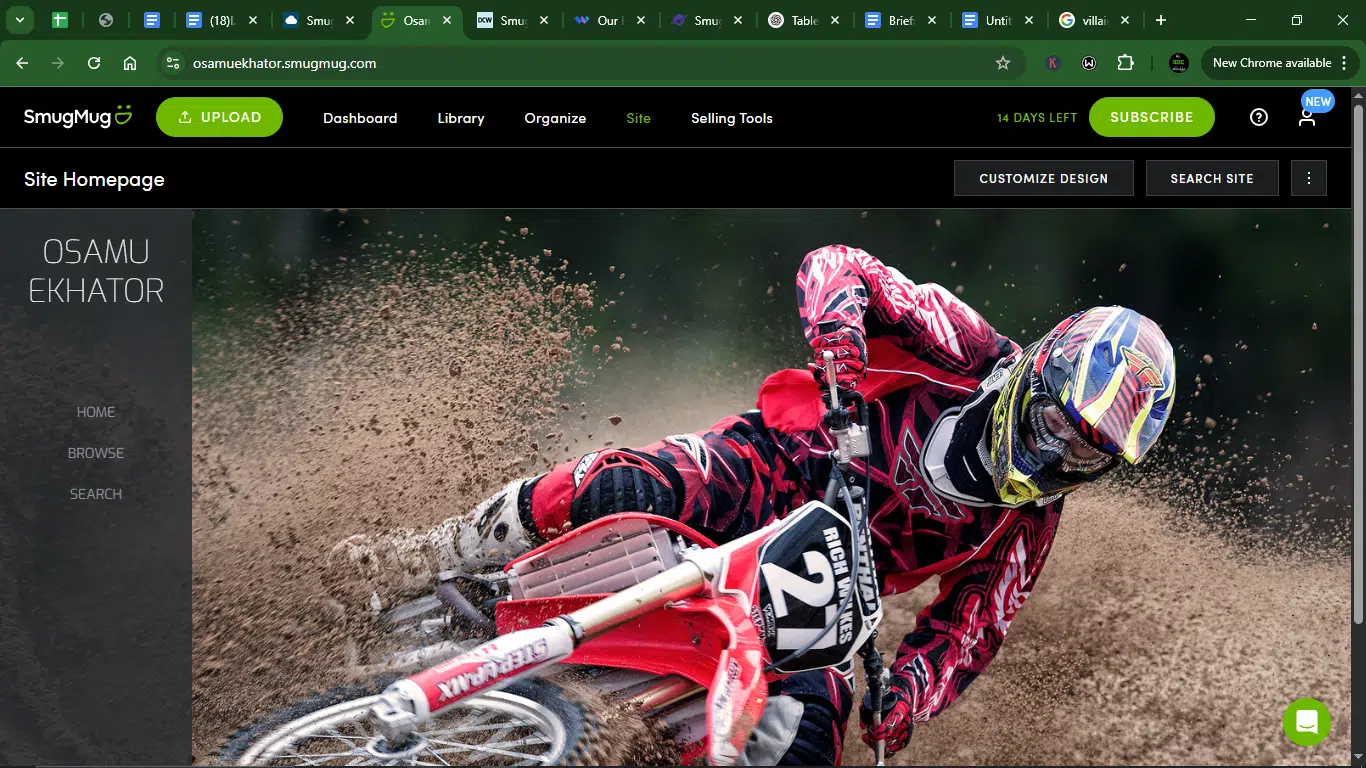
- Select a gallery: A pop-up box appears when creating a gallery. Select the “into new gallery” option. Pick “into existing gallery” if you want to add to a preexisting folder, or “upload folders” if you want to add more than just individual files.

- Fill out the form: Name your gallery in the “title” field. This name will also be used to generate a unique URL that you can share.
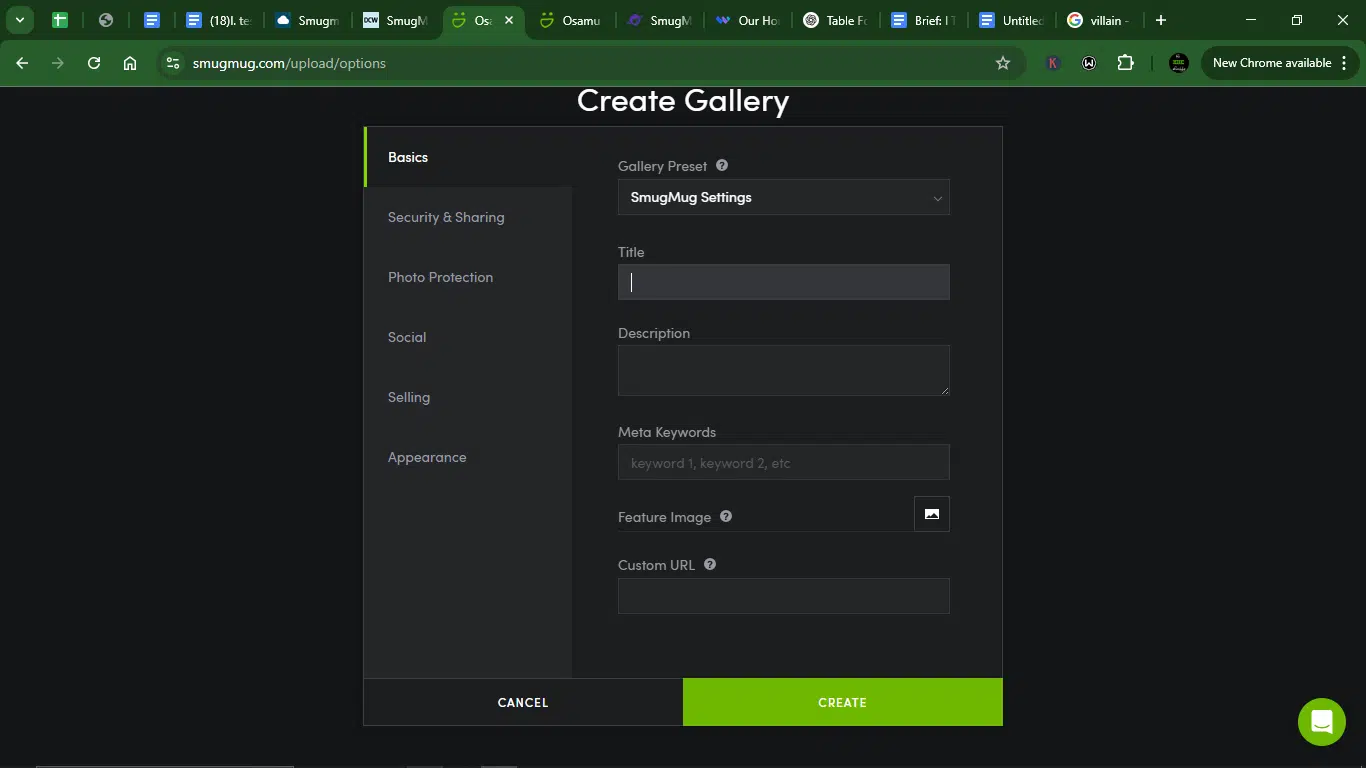
- Set security features: Select “security & sharing” in the left-hand menu to access the security features.

- Set your preferences: Under “Security & Sharing,” select “Access” and choose one of the three options in the dropdown menu based on the level of security (Anyone, people with a password, or people you choose) you want for your files.
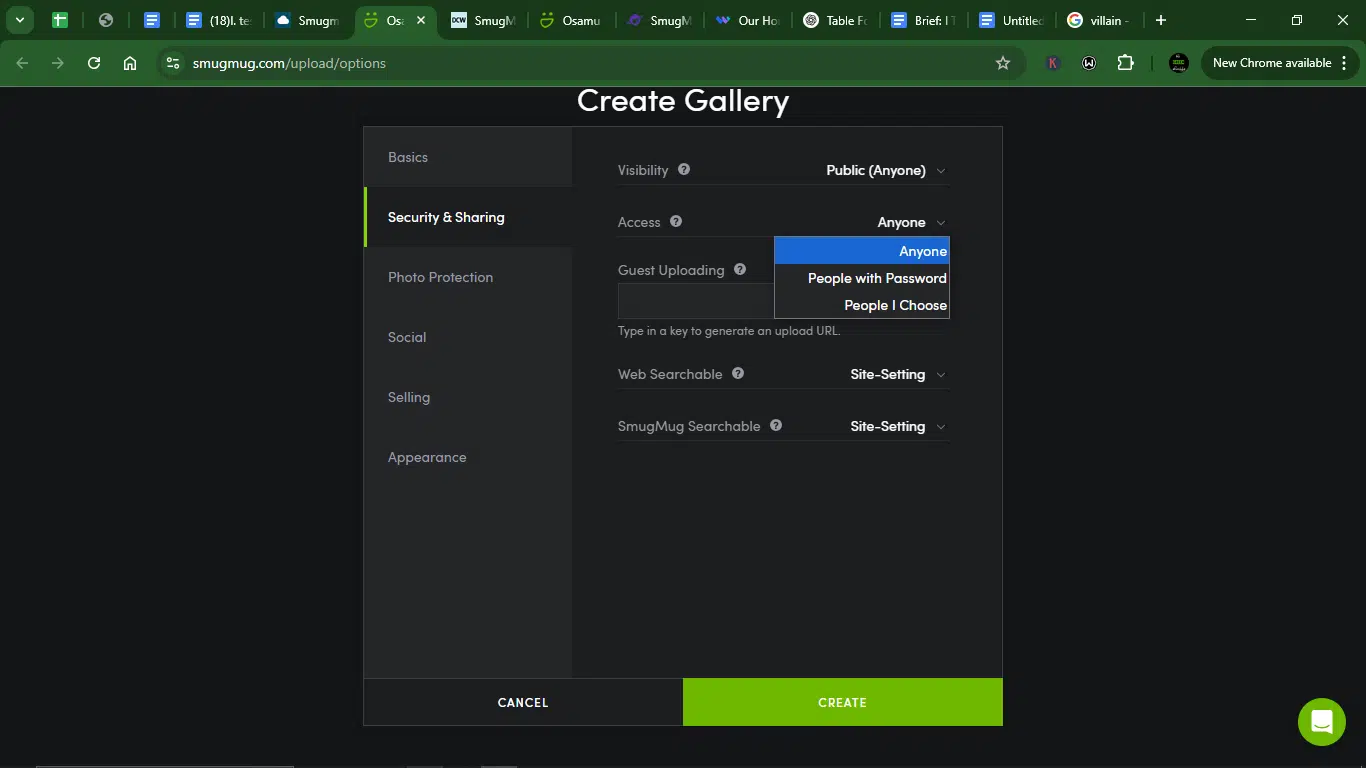
- Create a password: In the “visitor password” field (under “Access”), enter a strong password that other people can use to access the files you share.
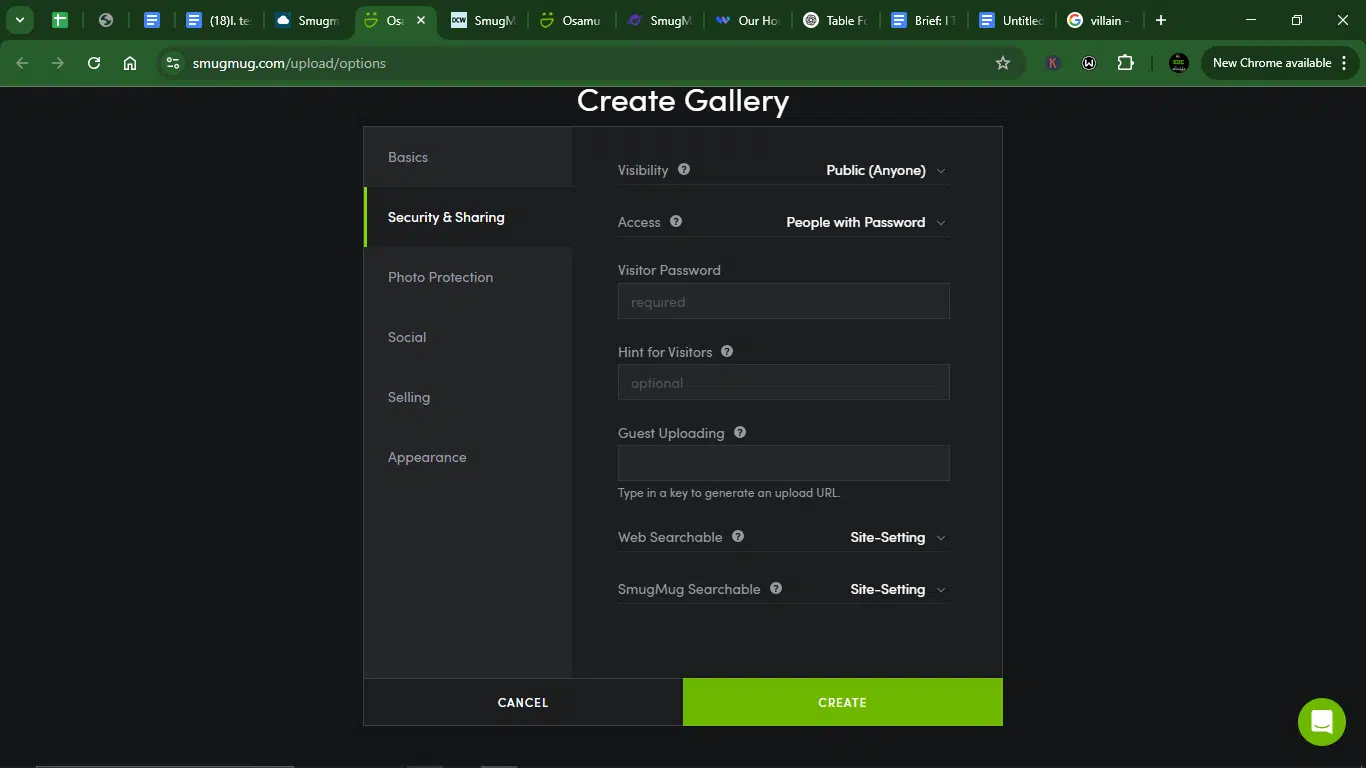
- Create folder: Click “create” at the bottom right of the page to create the folder.
- Add images: To add images, drag and drop them from your desktop or click “browse computer” and select the images you’re uploading.
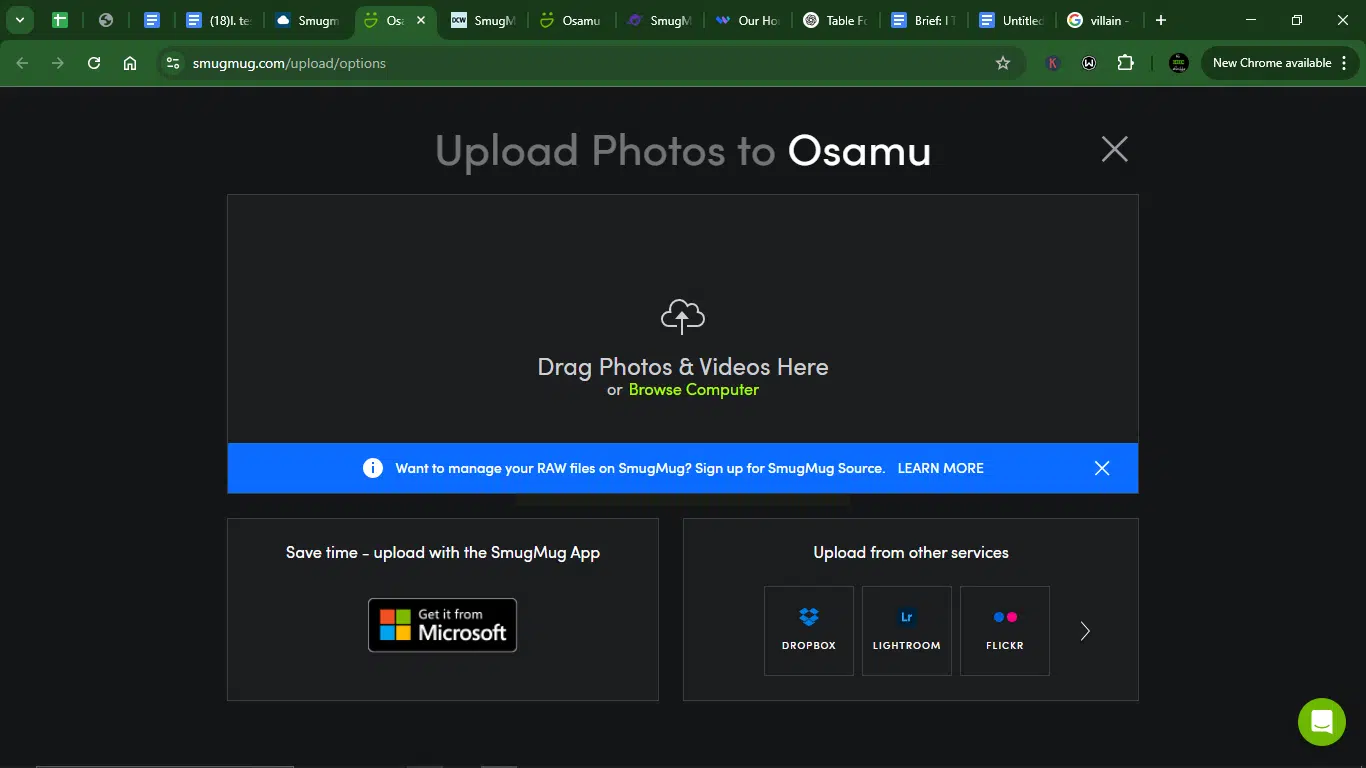
Key features:
- Unlimited photo storage: Upload all your high-res files without worrying about storage caps.
- Print fulfillment: Sell your work through integrated labs without lifting a finger.
- Secure client galleries: Password-protected galleries and download permissions.
- Privacy controls: Set access levels, apply watermarks, and prevent unauthorized downloads.
- Lightroom integration: Upload and manage photos directly from Adobe Lightroom.
- eCommerce tools: Set your prices, apply marketing coupons, and offer bundles.
- Custom domain support: Make your brand look legit with a personalized URL.
- 24/7 human support – Real people, always on call.
Pricing:
| Plan | Cost | Description | Best for |
| Direct | $25/month($210/year) | • Unlimited storage• Streamlined digital delivery• Powerful privacy controls• Seamless Lightroom integration• 24/7 live human support | Photographers who need a speedy and secure way to deliver photos. |
| Portfolio | $31/month($246/year) | • Sell prints and digital downloads• Watermarking and theft protection• Set profit margins &choose print products• Full-service customer order fulfillment• Easy delivery for your customers | Photographers selling photos and managing large archives. |
| Pro | $45/month ($384/year) | Includes Portfolio features, plus:• Multiple custom price lists for galleries• Offer marketing coupons and bundles• Client favoriting & customer download limits | Photographers looking to grow and scale. |
What I liked about SmugMug:
- Sales-ready galleries: SmugMug makes selling prints easy — the backend does all the heavy lifting.
- Secure and professional: From watermarks to password protection, your images are locked down.
- Photo-centric templates: Minimal, modern templates that put your work front and center.
- No storage limits: You’ll never hit a wall on how many photos you can host.
- Lightroom Sync: Seamless if you already work in Adobe’s ecosystem.
What I didn’t like about SmugMug:
- Not for casual creators: If you’re just showing off some hobby shots, this might be overkill.
- Limited templates: Just 26 to choose from, which can feel a bit restrictive.
- Clunky Interface: The UI feels a little outdated and not as intuitive as competitors like Wix.
- Rigid editor: You can’t drag and drop sections freely; design flexibility is limited.
- No free plan: Once your trial ends, you’ll have to pay or lose access. And nope, no refunds.
Photography website builder comparison table
| Tool | Best for | Pros | Cons | Starting price | Free or trial |
| Wix | Full creative control | Massive design freedom, flexible | It can feel overwhelming, performance may vary, pricey | $17/month | Free plan |
| Squarespace | Polished portfolio sites | Sleek design, mobile-ready, solid support | Limited customization, no autosave, pricey | $16/month | 14-day trial |
| WordPress + Elementor | Advanced users in need of full control | Total design freedom, scalable, tons of plugins and extensions | Steeper learning curve, hosting & security setup needed, can get expensive | $4/month for hosting on WordPress + $4.99/month for Elementor Pro | Free plan |
| Pixpa | Beginners & creatives on a budget | Easy setup, good value, versatile | Limited customization, slower support | $8/month (billed annually) | 15-day trial |
| Format | Professional photographers | Photographer-focused, strong eCommerce tools | Limited for general websites | $8/month | 14-day trial |
| SmugMug | Selling photo prints online | Print selling made easy, Lightroom integration | No free plan, fewer templates, limited design tools | $25/month | 14-day trial |
Why website builders are essential to photographers
No debate, photographers need an online presence more than ever in today’s digital world. A website allows photographers to showcase their portfolio, connect with potential clients, and even sell their work directly.
Here’s why website builders are essential for photographers:
- Professional online presence: A website allows you to present your work in a polished and professional manner, making it easier to gain credibility with clients.
- Portfolio showcase: Think of your website as a dynamic portfolio where you can organize your best work, showcase specific projects, and provide detailed context for each photo.
- Control over branding: Website builders give you full control over your branding, from the color scheme to the layout. This means your website can reflect your unique style and vision.
- Client proofing and communication: With client galleries, feedback tools, and direct messaging, photographers can communicate efficiently with clients, improving their experience and simplifying the process.
- eCommerce features: Many website builders include built-in eCommerce tools, allowing photographers to sell prints, digital downloads, or even offer booking services directly from their site.
- SEO benefits: Having a website allows you to optimize your content for search engines, making it easier for potential clients to find your work and services.
- Easy updates and maintenance: With website builders, photographers can easily make changes to their site without needing to learn code or rely on a web developer.
- Mobile-friendly: Most website builders offer responsive designs, meaning your site will look great on any device, ensuring your portfolio is accessible to clients on the go.
Challenges and ethical issues using website builders
While website builders offer numerous advantages, they come with their own set of challenges and ethical considerations. Here are some things to keep in mind:
- Limited customization: While website builders are user-friendly, they may limit creative freedom, especially if you need highly customized features. This can be a problem for photographers with specific requirements. Moreover, some website builders, like Wix, won’t let you change the template once the website has gone live.
- Ownership of content: Many website builders have terms of service that may allow them to use your content in ways you may not be comfortable with, including advertising or promotional purposes. Always check the fine print to understand your rights.
- Privacy concerns: If you’re collecting data from clients or customers (such as contact information or payment details), it’s important to ensure that the website builder you use complies with privacy regulations (e.g., The General Data Protection Regulation [GDPR]), Wix and Squarespace.
- Website performance: Some website builders may not offer the best performance, particularly if you have a large portfolio or require heavy multimedia elements. Slow loading times can impact user experience and SEO.
- Hidden costs: Many website builders offer affordable pricing at first, but the cost can increase with the addition of premium features, custom domains, or additional storage. It’s important to keep track of all costs involved. I’ve attached the cost for all six website builders in this article.
5 tips for building your photography website:
- Keep it simple: Your website should reflect your work, not overwhelm it. Choose a clean layout that prioritizes your photos over other content.
- Focus on your portfolio: The primary purpose of your website should be showcasing your work. Choose a platform with beautiful, high-quality templates that allow your photos to shine.
- Mobile responsiveness is key: Ensure the platform you choose offers mobile-optimized templates. Most of your users will visit your site from their phones, and you want to provide a seamless experience.
- SEO matters: Even if you’re just starting, you should consider SEO tools. It’ll help your site rank higher in search engines, meaning potential clients will find you more easily.
- Think about scalability: If you plan to grow your photography business, choose a platform that can evolve with you, offering more advanced features like eCommerce or blogging in the future.
Conclusion
Building a website is not optional for photographers. A website is a critical tool for showcasing your work, connecting with clients, and growing your business. Website builders have made it easier than ever to create a professional online presence, with a wide range of platforms catering to photographers’ specific needs. Whether you choose Wix, Squarespace, WordPress + Elementor, or any other platform, the key is to find the one that fits your style, budget, and goals.
Remember, a well-designed website not only helps you display your photography but also provides a professional platform for client interactions and sales. And as AI tools continue to improve, they can further enhance your website’s performance and business operations, giving you more time to focus on your creative work.
FAQs about website builders for photographers
Which website builder is best for selling photos?
SmugMug, Squarespace, and Pixpa offer the strongest built-in eCommerce tools for selling prints, digital downloads, or packages. SmugMug specializes in print fulfillment, while Squarespace excels in sleek product displays.
Do I need coding skills to build my photography website?
No. You can build your first site without writing a single line of code. Platforms like Wix, Pixpa, and Squarespace are drag-and-drop friendly. But if you’re aiming for pixel-perfect design control, WordPress + Elementor gives you that flexibility, though there’s a small learning curve.
How do I make sure my photos look great on my website?
Start by uploading high-resolution images. Most website builders I tried, like Squarespace, Wix, and Format, automatically optimize your images so they load fast without losing quality. Also, make sure the site uses responsive design so your work shines on both desktop and mobile.
Can I make my website look unique even if I use a template?
Absolutely. I’ve customized templates on Wix and WordPress + Elementor to the point where they look completely original. You can tweak layouts, fonts, colors, and more to reflect your style or brand vibe.
How can I protect my photos from theft online?
Platforms like Pixpa and Format come with built-in watermarking and client proofing tools. This helps keep your images safe while still letting potential clients browse your portfolio.
What’s the easiest builder for beginners?
From my experience, Wix and Squarespace are the easiest to get started with. Their editors are super intuitive, and they come with beautifully designed templates that make you look like a pro from the get-go.
Are there free website builders?
Yes, Wix and Elementor+WordPress offer free plans. Just know they usually come with limitations like ads, limited storage, or fewer features. Still, they’re a great way to test the waters before committing.
Why do I need a website if I already use Instagram??
Because your Instagram feed can only take you so far. A website gives your photography business a home, one you own. Whether you’re selling, booking clients, or just showing off your portfolio, it’s the smartest move you can make for long-term growth.
Disclaimer!
This publication, review, or article (“Content”) is based on our independent evaluation and is subjective, reflecting our opinions, which may differ from others’ perspectives or experiences. We do not guarantee the accuracy or completeness of the Content and disclaim responsibility for any errors or omissions it may contain.
The information provided is not investment advice and should not be treated as such, as products or services may change after publication. By engaging with our Content, you acknowledge its subjective nature and agree not to hold us liable for any losses or damages arising from your reliance on the information provided.
Always conduct your research and consult professionals where necessary.











